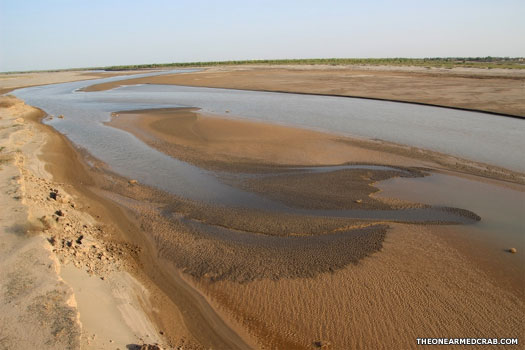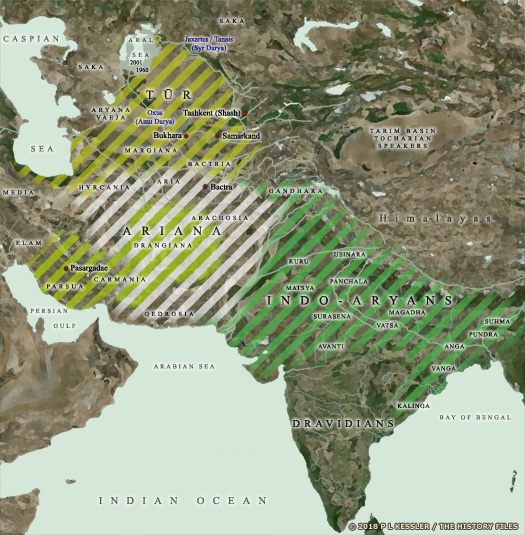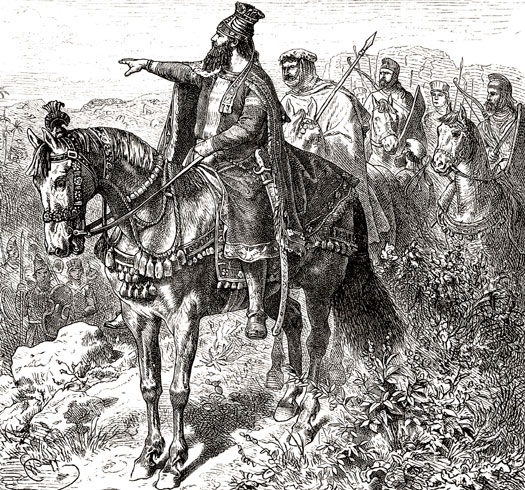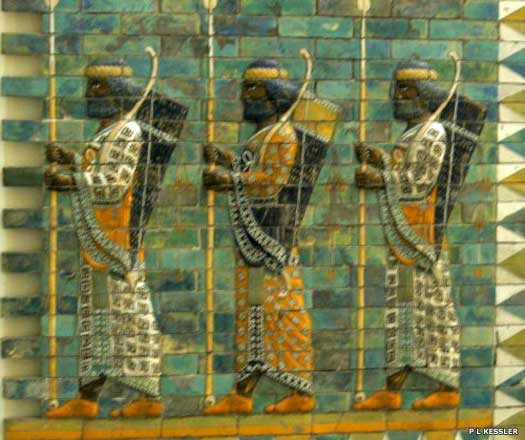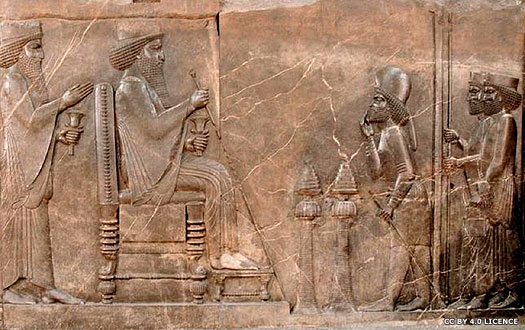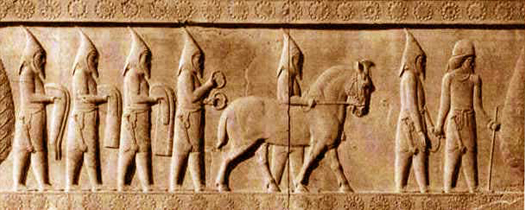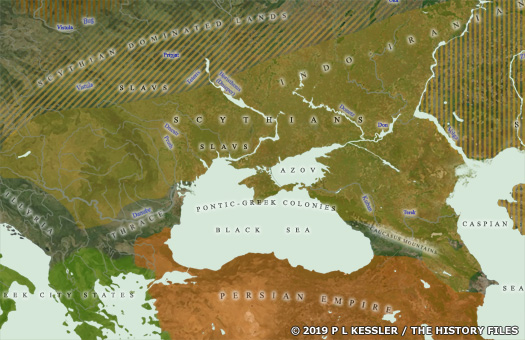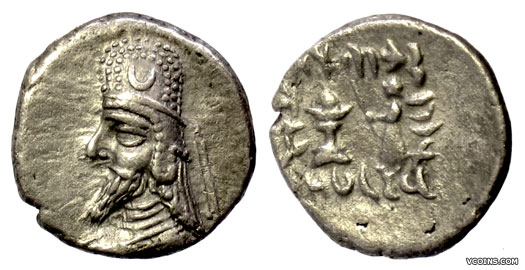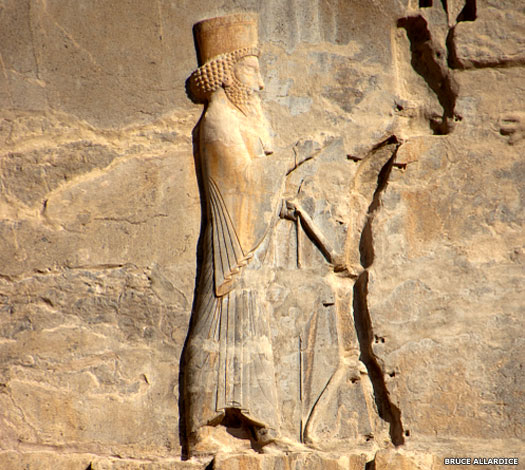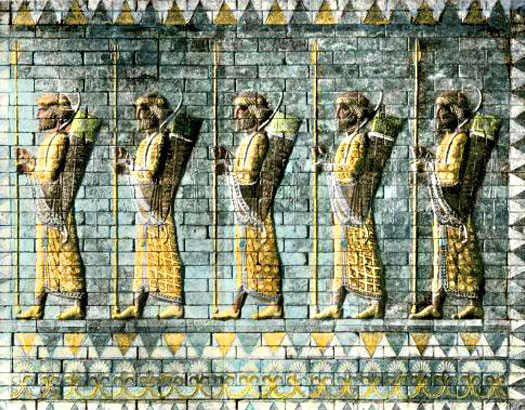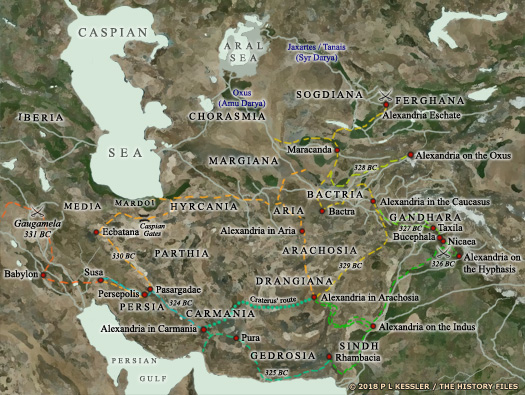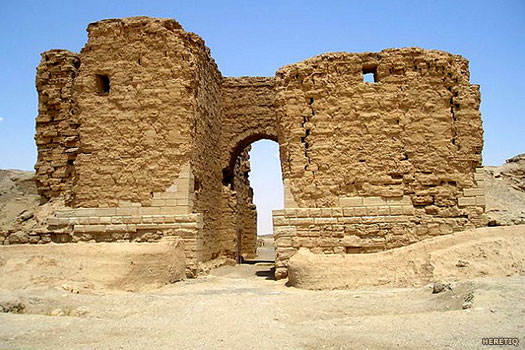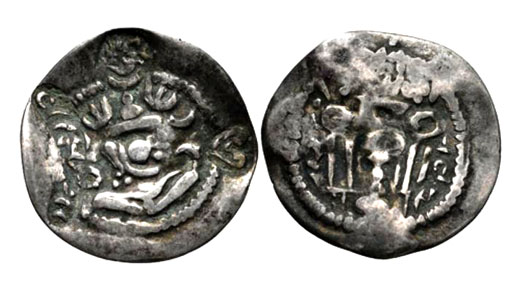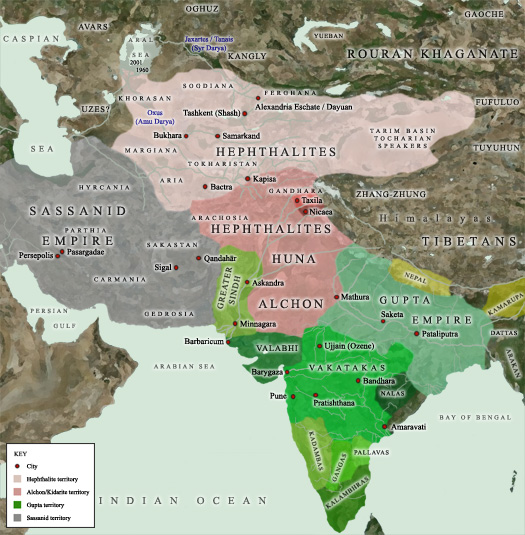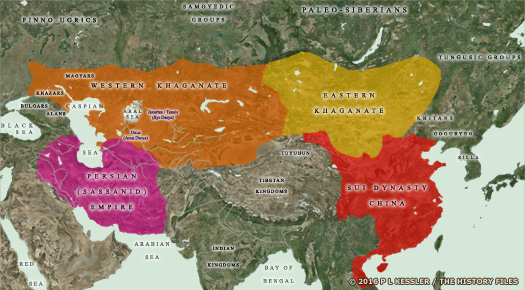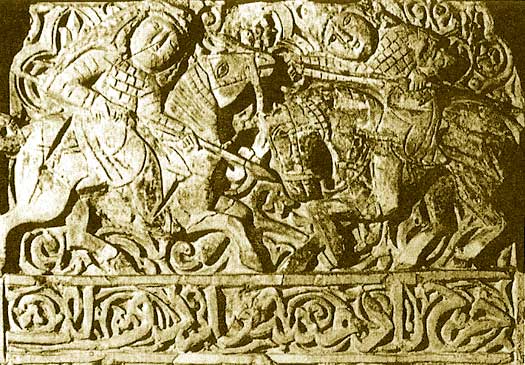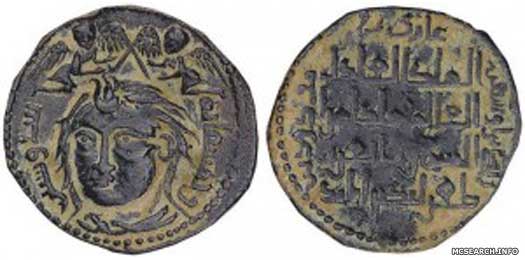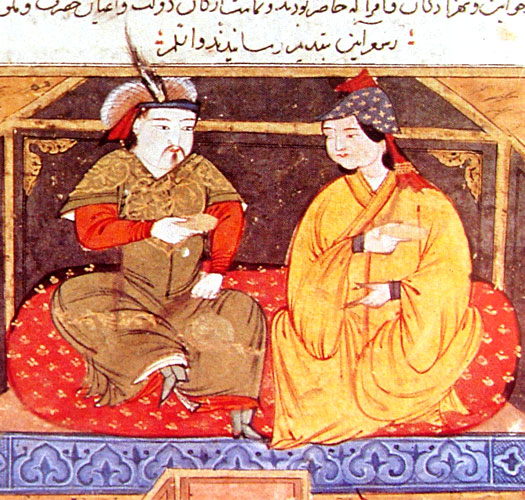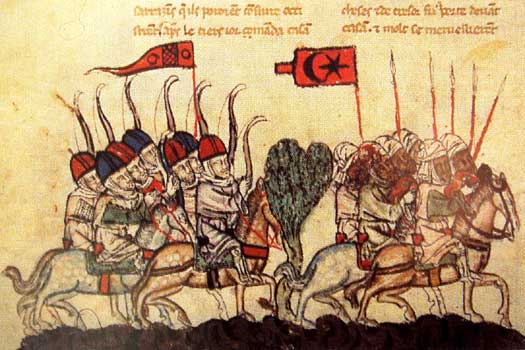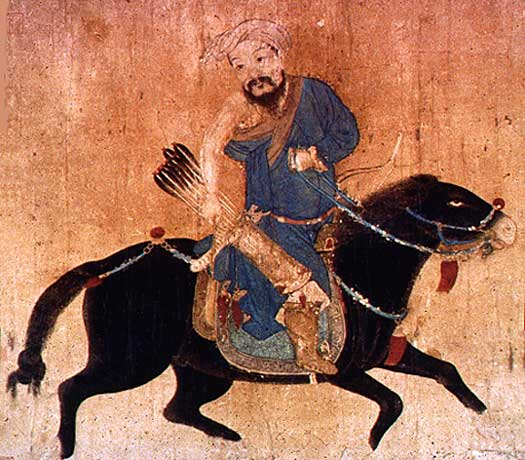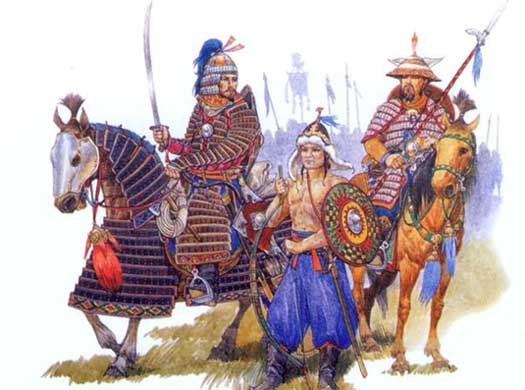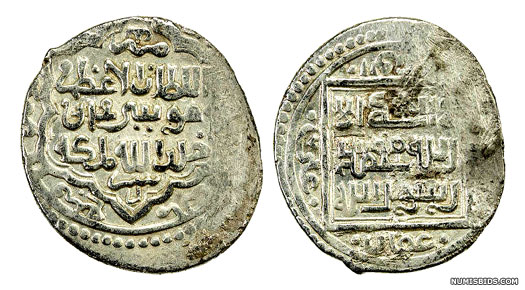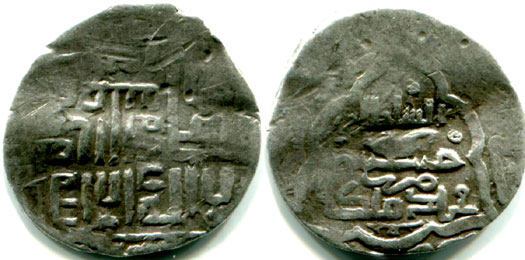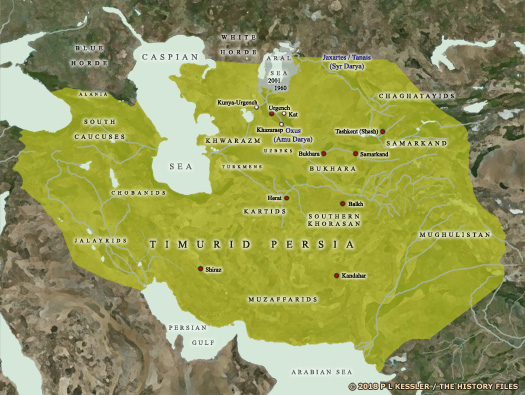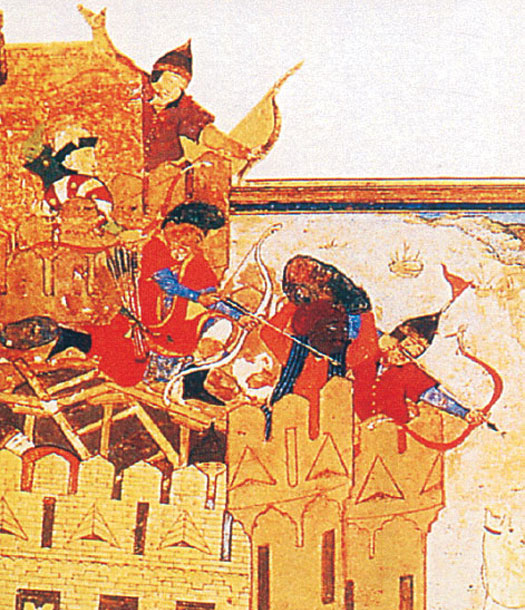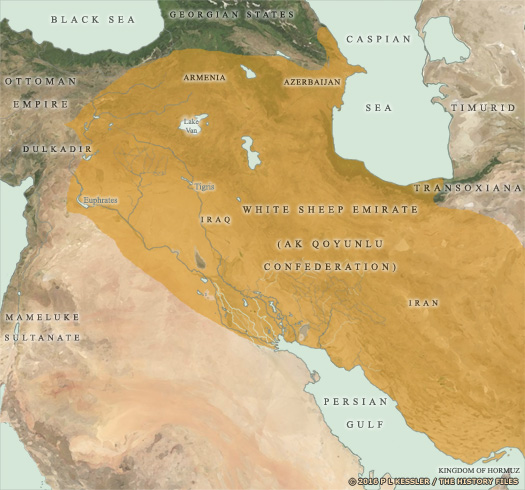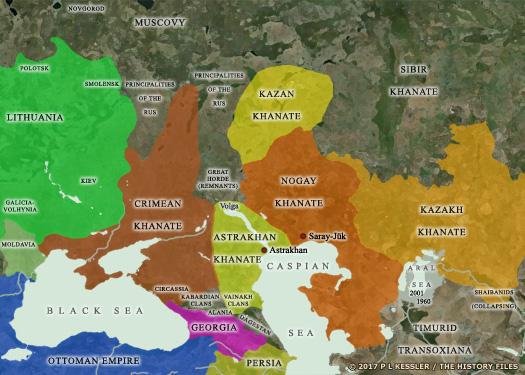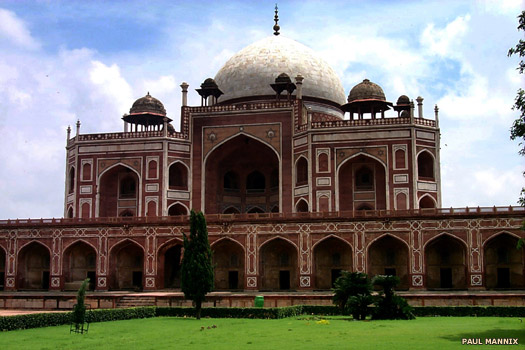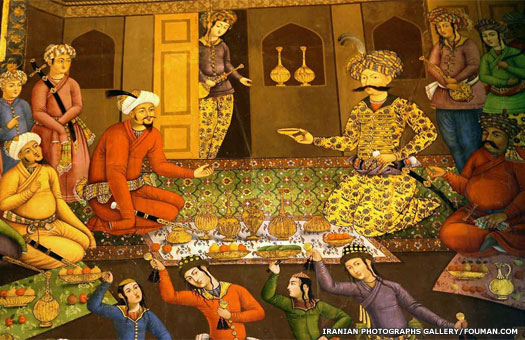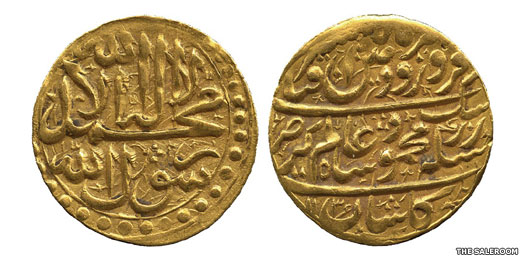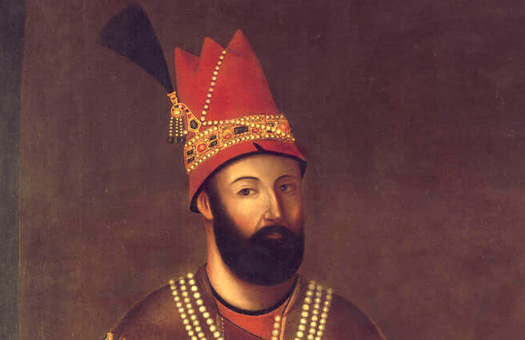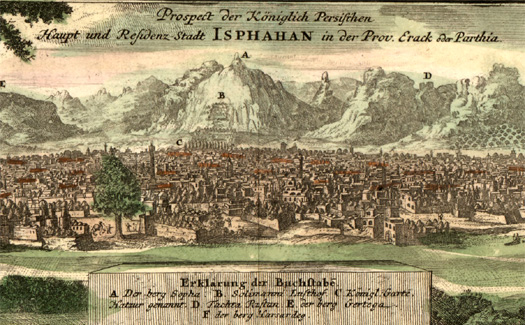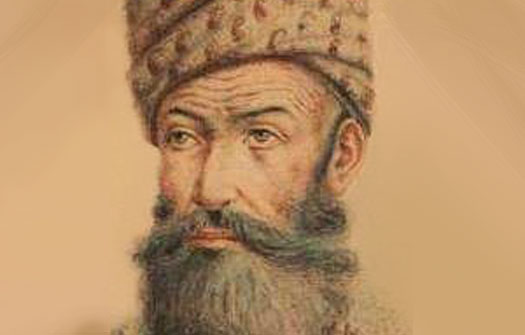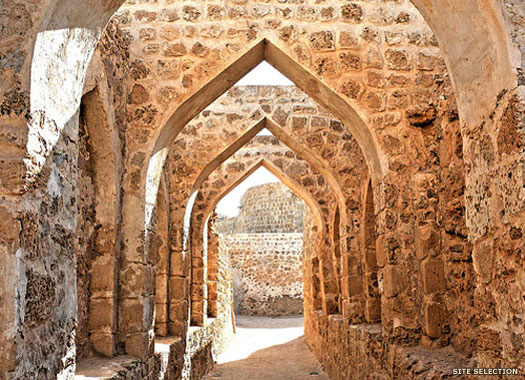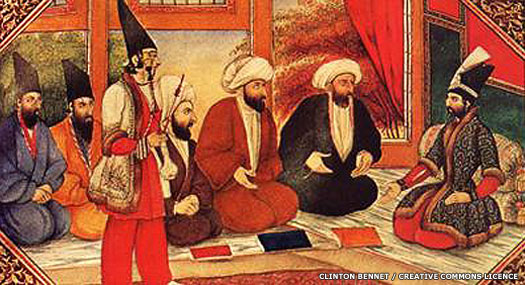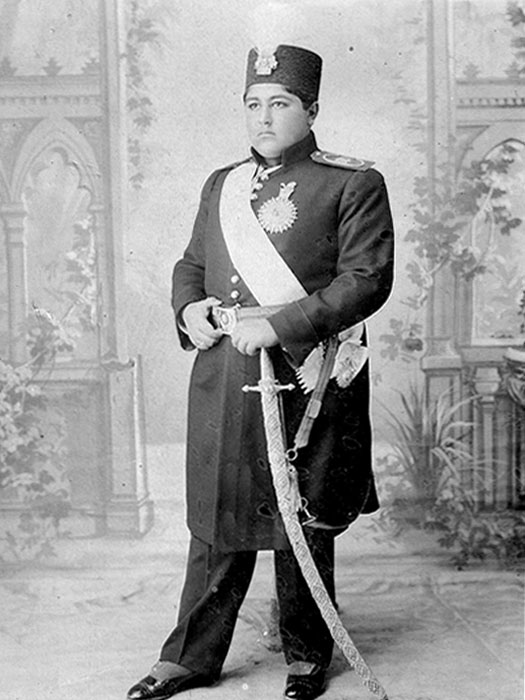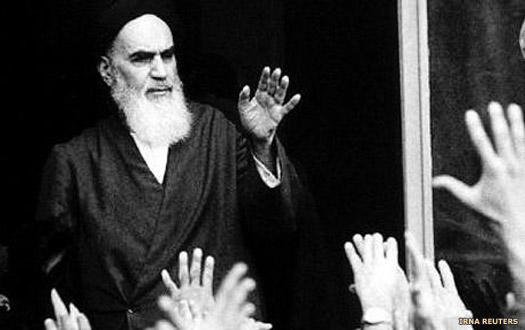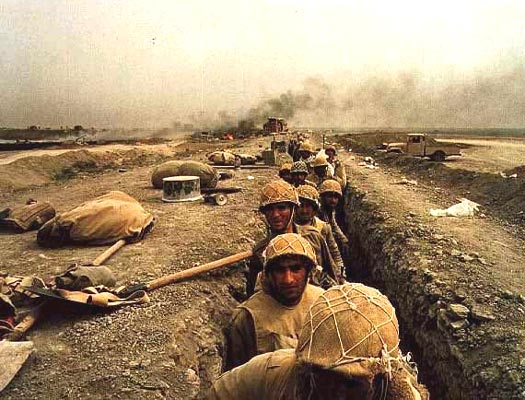
| PERSIA / PARSUA Incorporating the Daoi, Derousiaioi, Dropikoi, Maraphioi, Mardoi, Maspioi, Panthialaioi, & Pasargadoi :
The Persians (or Parsu, Parsua, Parsuash, Parsumash, from which the modern Fārs gained its name) were a later grouping of Indo-Europeans who migrated, probably along the River Oxus for part of its length, into Iran. They settled to the east of ancient Elam during the period of instability and migration which occurred throughout the Near East between 1200-900 BC. During this same period other tribal groups such as the Aramaeans and the Sea Peoples were causing chaos further west.
Despite occasional theories which have them descending from the Caucuses, the Persians were clearly of Indo-Iranian stock, an Indo-European grouping which formed in Central Asia, somewhere between modern Kazakhstan and Afghanistan. This origin has some support in the similarity of names towards the eastern side of the Caspian Sea, and the resemblance noted between Old Persian and Sogdian languages. They drifted into what is now Iran from the east alongside other similar groups which included the Alani, Mannaeans, and Medians, probably via Sogdiana and Transoxiana, not long after Indo-Aryan groups had started to enter India. That heritage would appear to make them descendants of Indo-Europeans who had bordered and integrated themselves into the Bronze Age culture known as the Bactria-Margiana Archaeological Complex, or Oxus Civilisation (centred on the later provinces of Bactria and Margiana). This had emerged between roughly 2200-1700 BC in Central Asia in modern Turkmenistan and towards the Oxus. Although this was originally an indigenous culture, it was almost certainly subject to a slow 'invasion' of Indo-European tribes in much the same way as the Pelasgians of Greece were largely subsumed by the Mycenaeans.
The semi-mythical early Persian 'kings' seem to rule their people in those Central Asian areas already mentioned, between the Oxus and parts of eastern Iran, but with a westwards drift towards Iran. In fact, one of the names given by the Thiruvalangadu copperplate grant of the Chola family in India, Aryaman (shortly after around 1000 BC), is the source of the name 'Iran'. This particular Aryaman was not the one who gave his name to that land, but either another (Persian) Indo-Iranian who also bore the name did just that, or the word originates in the name which the Indo-Iranians had for themselves - Aryans. 'Arya' meant the 'civilised' or 'respectable' (although the rather tainted 'Aryan' term has been replaced by modern scholars with the more accurate 'Indo-Aryan'). This rather elitist naming was presumably a reaction to the apparently barbarous people they encountered, although as a probable extension of its original meaning - the word could be seen as the verb 'to be', used as a noun instead of a verb.
The early Persians were better known by the civilisations of the west as Parsua. Seemingly arriving in multiple groups, some of them initially spread into the Zagros Mountains alongside the Medians, before these groups were expelled or absorbed by their more numerous Median cousins. A large group also began to settle in southern Iran, in an area to the immediate east of the kingdom of Elam which became known as Persis. The capital of the Parsua until 559 BC was Pasargadae in Fārs, in the heartland of ancient Persis. Increasing dominance in the sixth century BC saw them move that capital to the former Elamite capital at Susa. In effect, they were Elam's successors, inheriting its language and culture but infusing it with a good deal of their own.
The Parsua which were settling in southern Iran consisted of ten 'clans' (gene). Noted later by Herodotus (and therefore given with the Greek forms of their names alone), these ten clans existed around the mid-sixth century, when the Parsua were fighting to end Median vassalage. The three clans which turned up to aid Cyrus were the Maraphioi, Maspioi, and Pasargadoi, the latter being the noblest of all and the clan which included the Achaemenids themselves. The other clans were dependant upon these three. Four of those were nomadic pastoralists, the Daoi, Mardoi (with a bad reputation as predatory folk), Dropikoi, and Sagartioi (who seem to have had a tribal homeland in Drangiana). Two of those are known from other sources.
The final three clans were sedentary cultivators, the Germanioi (clearly meaning Carmanians), Panthialaioi, and Derousiaioi. With the Sagartioi residing in Drangiana, the Karmana in Carmania, and the remaining Parsua in Persis, a clear migratory path onto Iran can be discerned. A basic study of Iran from the Roman itineraries by Tomaschek noted Pantyene/Pathienas as the first station (at sixty parasangs, 322 kilometres, two hundred miles) on the route from Persepolis to the Ichthyophagi (Fish-Eaters, on the Persian Gulf coastline). He convincingly fixed it at Sirjan on the western border of the modern Kerman Province. If Pathienas can be equated with the Panthialaioi then it would place another of the clans pretty far to the east of Persis, settling down along the migration route from Central Asia.
(Additional information by Jo Amdahl and Edward Dawson, from Empire of Gold: Foundations, Jo Amdahl, from The Horse, the Wheel, and Language: How Bronze-Age Riders from the Eurasian Steppes Shaped the Modern World, David W Anthony, from Central Asia: A Historical Overview, Edward A Allworth (Duke University Press, 1994), from The Paths of History, I M Diakonoff (Cambridge University Press, 1999), from Islamic Reference Desk, Emeri 'van' Donzel (Brill Academic Publishers, 1994), from The Persian Empire, J M Cook (1983), from The Routledge Handbook of the Peoples and Places of Ancient Western Asia, Trevor Bryce, from The Histories, Herodotus (Penguin, 1996), from Zur historischen Topographie von Persien. II. Die Wege durch die Persische Wüste, Wilhelm Tomaschek (1885), from Farāmarz, the Sistāni Hero: Texts and Traditions of the Farāmarznāme and the Persian Epic Cycle, Marjolijn van Zutphen, from External Links: Encyclopaedia Iranica, and Iranians & Turanians in the Avesta, and The Cities of the Medes (full text), Mordechai Cogan & Israel Eph'al (Eds, The Hebrew University, Jerusalem), and in reference to a further number of original and secondary sources included in the 'Persia and Eastwards' section of the Sources page.)
c.1000 - 900 BC :
The Parsua begin to enter Iran, probably by crossing the Iranian plateau to the north of the great central deserts (through Hyrcania, probably skirting to the north of neighbouring Parthia) but also by working round to the south of the deserts. Already separated during their journey, Parsua groups head in two main directions. In time the northern groups find themselves in the Zagros Mountains alongside their cousins, the Mannaeans and Medians. They are attested there during the ninth and eighth centuries but disappear afterwards. The southern groups, perhaps more numerous, trickle in through Drangiana and Carmania, towards southern Iran and begin to settle there.
Located in the Fārs region of Iran, these Parsua come under the overlordship of their once-powerful western neighbour, the kingdom of Elam. In the later stages of Persian settlement, Assyria and Media also claim some control over the region. As Elam's influence weakens, the Persians begin to assert their own authority in the region, although they remain subjugated by more powerful neighbours for quite some time.
The River Oxus - also known over the course of many centuries as the Amu Darya - was used as a demarcation border throughout history - it was also a hub of activity in prehistoric times, providing a home to the Bactria-Margiana Archaeological Complex, or Oxus Civilisation c.843 BC :
The Parsua receive their first mention in history. The Assyrian king, Shalmaneser III, records their existence on the Black Obelisk, which covers his campaign of about this year. Their position is not precisely fixed but 'Pasua' seems to lay in what is now Iranian Kurdistan (immediately east of Kurdistan in northern Iraq), far to the north of Persis and the heart of Persian settlement. They also occupy territory which stretches back into the east, seemingly along the Great Khorasan Road which follows the southern edge of the Elburz Mountains on the south coast of the Caspian Sea (largely within the later province of Hyrcania).
It may be the case that there are two (or perhaps even three) distinctive groups of 'Parsua' at this time, primarily in the Zagros Mountains to the east and south-east of the Assyrians. This is apart from a larger body which is settling the land immediately to the east of Elam (and focussed around the city of Persis). Those groups in the Zagros seem to drop out of the historical record towards the end of the eighth century BC (after 714 BC), perhaps pushed south by the greater numbers of the Medes or absorbed by them.
8th cent BC :
Later myth ascribes a dynasty of rulers to this period, as described in the Shahnameh (The Book of Kings), a poetic opus which is written about AD 1000 but which accesses older works and perhaps elements of an oral tradition. The Kayanian dynasty of kings are also the heroes of the Avesta, which forms the sacred texts of Zoroastrianism. This faith itself is founded along the banks of the River Oxus, which probably also forms part of the migratory route used by the Indo-European Parsua as they enter Iran.
The earliest of these rulers is Fereydun, king of a 'word empire' which is apparently centred on the land of Tūr. This can be equated to territory in the heartland of Indo-Iranian southern Central Asia and South Asia, focused mainly on the later provinces of Bactria and Margiana, along with the Kopet Dag region, the Atrek valley, and the eastern Alborz Mountains. This would appear to place it on the northern border of another ancient region, that of Ariana.
Fereydun becomes the father of Tūr, Salm, and Iraj. A descendant of the first of these (possibly a seven-times grandson) is Afrasaib, who still rules the kingdom of Turan during the lifetime of Kai Kavoos of the seventh century (see below).
Fereydun / Faridun / Fareidun : Ruled a 'world empire'. Abdicated in favour of Manuchehr.
Iraj : Son. Gifted Iran. Killed by Tūr of Turan.
Fereydun / Faridun / Fareidun : Manuchehr
Thanks to the murder of Iraj by Tūr and Salm, the Parsua retaliate under the command of Iraj's grandson, Manuchehr. One of the leading warriors under his command may be Garshāsp (possibly also known as Karāsp), a figure of the Shahnameh or Shahnama, the Book of Kings and a possible descendant of the mythical Indo-Iranian King Jamshid. Tūr and Salm cross the Oxus to face Manuchehr's army on the border between Iran and Turan. The ensuing battle results in heavy casualties for the Turanians, and Tūr is later ambushed and beheaded. Salm is later captured and also beheaded.
Following the climate-change-induced collapse of indigenous civilisations and cultures in Iran and Central Asia between about 2200-1700 BC, Indo-Iranian groups gradually migrated southwards to form two regions - Tūr (yellow) and Ariana (white), with westward migrants forming the early Parsua kingdom (lime green), and Indo-Aryans entering India (green) 744 BC :
The Medes to the west of the Gizilbunda Mountains (part of the Zagros range) have enjoyed a respite in the past few years. Now a new Assyrian advance begins when the king invades Parsuai and turns it into an Assyrian province (also known as Nikur, after its capital). This refers to Parsua, but not those of southern Iran. This is one of the northern groups which had settled in the Zagros Mountains. Nikur may not be too far to the west from the later city of Ecbatana.
Possibly in the same year the Assyrians make a raid farther to the east, reaching Arazias, and a Median fortress called Zakruti. Tiglath-Pileser demands that in the whole country of the mighty Medes as far as Mount Bikni (possibly Mount Demavend close to modern Tehran), the 'lords of townships' should pay him regular tribute of nine metric tons of lapis lazuli and fifteen tons of bronze artefacts, an impossible order to fulfil.
Nowzar : Son and early king. Killed by Afrasiab of Turan.
Kai Kobad / Kei Qobád : Kayanian dynasty founder who united the Aryan tribes.
According
to tradition, probably largely oral until it was written down in
the eleventh century AD, Kai ('king') Kobad lives in the Alborz
Mountains, a range which stretches from the borders of modern Armenia,
across northern Iran to the border between modern Turkmenistan and
Afghanistan. This seems to support the evidence of a Persian migration
from further north and east, and may be used to show that they have
not yet fully settled in Persis itself.
7th cent BC :
Kai Kavoos / Kay Kāvus : Mythical early Persian king.
The wife of Kai Kavoos, Sudabeh, attempts to persuade his son, Sijavus, to betray the king in return for sex, but Sijavus refuses and goes into voluntary exile in the 'land of Tur' in Sogdiana. His son, Kai Khosrow, is chosen by Kai Kavoos as his successor as leader of the Parsua.
Kai Khosrow : Son of Sijavus. Later king of Parsua. Reigned for about 60 years.
Kai Lohrasb / Luarsab : Chosen successor of Kai Khosrow.
Kai Garshasp / Goshtasp
Kai Bahman / Wahman : Son of Esfandiyar and grandson of Garshasp.
The Bahamani sultanate of the fourteenth century AD, which is located on the Deccan plateau in central India, claims descent from Kai Bahman. Thanks to this supposed connection, they maintain a keen interest in Persian affairs and culture.
692/691 BC :
Khumma-Menanu of Elam king leads a coalition of states against Assyrian king Sennacherib at the Battle of Halule on the Tigris. With him is Babylon, the minor kingdom of Ellipi (roughly located in Luristan, to the immediate west of Elam), and the kingdom of Anshan which seems able to be able to call on the Parsua or Parsuash (Persians). Anshan has often - but not always - been part of Elam itself, but it may be ruled by a subsidiary line at this time. The location of the battle suggests a march by the allies towards the heart of Assyrian-dominated territory. The outcome is not decisive, and does not prevent Sennacherib from devastating Babylon, although it does protect Elam itself.
Kai Darab / Dara : Son.
675 BC :
At a time which may fit in with the end of the Kayanian kings, the Parsua begin to unite under the (legendary) founder of their new dynasty. Many scholars of Persian history now believe that Achaemenes is a fictional common ancestor who is used to legitimise the rule of Darius I from 521 BC. Darius goes so far as to install inscriptions on the unfinished palace of Cyrus the Great at Pasargadae which reads 'I am Cyrus, the king, the Achaemenid.'
No record of Achaemenes can be dated earlier than the reign of Darius I, and there is no indication of how Achaemenes may be related to the earlier, semi-mythical Parsua leaders. Nonetheless, the name 'Achaemenid' has been commonly accepted for the line of Persian kings beginning with Darius I, and Achaemenes is commonly accepted as leading the Parsua to their new home in Persis, ending their slow migration across Iran. Some sources use the term Achaemenid to refer to the entire line of early Persian rulers, including both Cyrus and Cambyses (600 BC).
c.675 - 640 BC :
Achaemenes (Hakhamanish) : 'King of Anshan'. Vassal of the Medes.
644 BC :
Neo-Elamite Period III begins as Elam is devastated by Assyria, although not as badly as had previously been believed from inscriptions left by the Assyrians themselves. The populace suffers greatly, but they are not massacred. Instead, the fragmented and weakened Elamites rule an increasingly shrinking domain which eventually passes into the hands of the Parsua. They gain Anshan (Anzan) even while the last seventh century Elamite kings are still claiming it within their title, possibly as a result of the Assyrian attack on the Elamites in this year as it ties in with Achaemenes of the Parsua being acclaimed as the king of Anshan.
With the accession of Achaemenes as leader of the Parsua, seemingly without a link to the previous ruling dynasty, the Kayanians, the accession becomes somewhat confused. Achaemenes is thought to complete the Parsua migration into Persis, so perhaps the Kayanians have been left behind in the east, looking after their gains in Turan.
The main line of descent from this point, via Teispes, Cambyses I, Cyrus II, and Cambyses II, is laid down by Babylonian scribes on the Cyrus cylinder of 539/538 BC. Darius I, from 521 BC, complicates matters with his Behistun inscription. He claims a line of descent from Teispes via Ariaramnes, Arsames (both shown below), and Hystaspes (a satrap of Parthawa). Ariaramnes and Arsames have been assumed to be a junior (cadet) line of the royal house, although their spans would seem to be rather long for the age in which they lived. Darius claims that both Hystaspes and Arsames are alive when he becomes king. Whilst this is possibly for Hystaspes, could he be speaking figuratively in terms of Arsames? If he is indeed alive, he would be very old indeed, possibly approaching a hundred.
? BC :
Teispes (Chishpish) : Son. King of Parsua (Anshan). Vassal of the Medes.
c.640 - 600 BC :
Cyrus I (Kurush of Parsua) : Son. King of Parsua (Anshan). Vassal of the Medes.
fl c.620s BC :
Ariaramnes (Ariyaramna) : Brother. Also king, perhaps a sub-king?
Ariaramnes
is generally assumed to be the brother of Cyrus I. He becomes the
father of Arsames, who becomes the father of Pharnaces, whose son
Artabazus becomes the first satrap of Phrygia. The other son of
Arsames is Hystaspes, satrap of Parthawa, who is the father of Darius
the Great according to Darius' own Behistun inscription.
c.620 BC :
The
Medes (possibly) take control of Parsua (Persis) from the weakening
Assyrians who themselves had only recently taken control of the
region from Elam. According to Herodotus, Media governs all of the
tribes of the Iranian steppe. This sudden empire may well include
territory to the east which covers Hyrcania, Parthia, Drangiana,
and Carmania.
c.600 - 559 BC :
Cambyses (Kambuzya of Anshan) I : Son of Cyrus. King of Parsua (Anshan). Last Median vassal.
fl c.570s BC :
Arsames (Arshama) : Son of Ariaramnes. Also king, perhaps a sub-king?
559 - 549 BC :
Before this date, Cambyses has married Mandane, (a) daughter of Astyages of Media. Their son is Cyrus, later known as 'the Great', while Mandane is also the niece of Amyhia, queen of Babylon. The truth of this apparent dynastic connection with the Medes has long been doubted, although there is no real reason to doubt general familial connections between the Indo-Iranian Medes and Parsua.
Cyrus, now king himself, ends the vassalage of the Parsua, or Persians, by defeating the Medes during the course of a four year war between 553-549 BC. The braver Parsua sometimes have to yield to the superior numbers of the Medes and eventually have to concentrate their women and children on the mountain of Pasargadai, where they are besieged by the Medes. Cyrus is victorious, seemingly after the Medes mutiny against their king and hand him over to the Parsua. Apparently, according to ancient writers, the defeated Astyages is subsequently granted the position of satrap of Verkâna. With Cyrus now king of the Parsua and Medes, he swiftly creates a great empire.
Achaemenid
Persia (Persian Empire) :
Cyrus the Great built the Persian empire from its small beginnings in south-western Iran by taking over the so-called Median empire (which probably stretched far back towards the east of modern Iran). His son consolidated those gains and extended them into Egypt. On the other hand, in some circles Darius I is thought to have been a usurper of the Persian throne, or at least an opportunistic claimant. Going back to the titular founder of the dynasty, many scholars of Achaemenid history now believe that the eponymous Achaemenes was a fictional common ancestor who was used to legitimise Darius' rule. Darius went so far as to install inscriptions on the unfinished palace of Cyrus the Great at Pasargadae which read 'I am Cyrus, the king, the Achaemenid'. No record of Achaemenes can be dated earlier than the reign of Darius I. Nonetheless, the name 'Achaemenid' has been commonly accepted for the line of Persian kings beginning with Darius I. Some sources use the term to refer to the entire line of early Persian rulers, including both Cyrus and Cambyses. The name is the Latin version of the original Old Persian Haxāmani, but this seems not to be used in modern writing.
During his empire-building phase, Cyrus mounted a campaign to the east of Persis and the former Median territories, marching through much of South Asia outside India and also the southern areas of Central Asia. These were his ancestral homelands, the Indo-Iranian melting pot from which the Parsua had migrated in the first place to reach Persis. There would have been no language barriers for his forces and few cultural differences. Although details of his conquests are relatively poor, he seemingly experienced few problems in uniting the various tribes under his governance. He was the first to exert any form of imperial control here, although his campaign may have been driven partially by a desire to recreate the semi-mythical kingdom of Turan in the land of Tūr, but now under Persian control. Curiously the Persians had little knowledge of what lay to the north of their eastern empire, with the result that Alexander the Great was less well-informed about the region than earlier Ionian settlers on the Black Sea coast had been.
Each Achaemenid ruler is usually known by the Greek or Latin form of his name simply because it was the Greeks who best recorded this history, and then the Romans inherited this work and enlarged upon it. For reasons of accuracy and completion, the original Persian versions are included in parenthesis. One of the very first acts of Cyrus the Great was to move the Persian capital to the former Elamite capital of Susa. In the later Behistun inscription of Darius the Great this land is known as Uwja or Ūja, and was part of the 'Great Satrapy Pārsa/Persis', or rather Persis and Ūja were two 'main satrapies' which were governed together and from the same place.
In fact Persis itself was not a satrapy, although it is sometimes referred to as one. As the oldest and most senior province of the empire it was also the heartland of the Persian kingdom and stood above mere subservient satrapies. Those occupants of the senior post in the administration, people who would be termed satraps elsewhere, could probably be best described as chancellors or controller-generals (the former term is used here). The precise boundaries of Persis are somewhat anomalous and, confusingly perhaps, it didn't include under its direct administrative control the satrapy of Susa. Classical authors also provide the names of some of the chancellors of Persis (shown below), with an apparent capital at Pasargadae, scene of the Parsua victory over the Medes. Persis also oversaw the minor satrapy of Karmana to its east.
(Additional information by Jo Amdahl and Edward Dawson, from Empire of Gold: Foundations, Jo Amdahl, from The Marshals of Alexander's Empire, Waldemar Heckel, from Alexander the Great and Hernán Cortés: Ambiguous Legacies of Leadership, Justin D Lyons, from A Political History of the Achaemenid Empire, M A Dandamaev, from The Persian Empire, J M Cook (1983), from The Histories, Herodotus (Penguin, 1996), from Nomadism in Iran: From Antiquity to the Modern Era, Daniel T Potts, from Ctesias' Persica in its Near Eastern Context, Matt Waters, from Alexander The Great: In the Realm of Evergetǽs, Reza Mehrafarin, and from External Links: Zoroastrian Heritage, K E Eduljee, and Encyclopaedia Iranica, and with reference to a large number of original and secondary sources that are included in the 'Persia and Eastwards' section of the Sources page.)
559 - 530 BC :
Cyrus (Kurush) II the Great : Son of Cambyses. Created the Achaemenid empire.
559 - 549 BC :
A vigorous ruler, one of Cyrus' very first acts in 559 BC is to move the Persian capital to the former Elamite capital, Susa. In the later Behistun inscription of Darius the Great this land is known as Uwja or Ūja, and is part of the 'Great Satrapy Pārsa/Persis'. Then, from 553 BC, he sets about releasing the Persians from vassalage. Herodotus tells the story of how the Medes lose control of the Persians when Cyrus rebels. In 550 BC (or 549 BC) Cyrus wins a decisive victory and Astyages of the Medes is captured by his own nobles and handed over.
Cyrus the Great freed the Indo-Iranian Parsua people from Median domination to establish a nation that is recognisable to this day, and an empire that provided the basis for the vast territories that were later ruled by Alexander the Great The sources conflict when it comes to explaining the precise relationship between Cyrus and Astyages. According to some, Cyrus is his son-in-law, while others state that he is his grandson and the legal heir of Media. The two versions are not necessarily in conflict with each other. Cyrus is Astyages' grandson through the latter's marriage to a Persian princess. In addition, Cyrus has also married his aunt, Astyages' daughter, Amyhia (not to be confused with his sister of the same name!), in order to cement his claim to the Median throne.
559 - ? BCSybares / Soebaris : First chancellor of Pārsa/Persis.
559 BC :
The
Persian Sybares had been released from Median slavery by Cyrus the
Great and became the king's companion in his undertakings. Now,
at the beginning of the reign of Cyrus, he appoints Sybares to the
position of satrap of Persis.
549 - 540 BC :
The defeat of the Medes opens the floodgates for Cyrus with a wave of conquests, beginning with Cilicia in 549 BC. Harpagus, a Median of the royal house and the main cause of Astyages' defeat, commands Cyrus' army in Anatolia, conquering it between 547-546 BC. Taken during this campaign are Armenia, Caria, Lycia, Lydia, Paphlagonia, Phrygia, and Tabal (Cappadocia), and Harpagus and his descendants reign thereafter in Caria and Lycia (and apparently Cilicia too) as satraps. Harpagus also takes on the satrapy of Sparda following the death of its satrap.
Cyrus next moves his army to the Tigris, below Arbela, where he marches against the land of Lu-[?], kills [?], its king, takes its booty, and sets up a garrison there. Unfortunately the name of the land is not quite legible. Various guesses have been taken, most of them improbable, with the most likely target in fact being Lydia, perhaps after an initial campaign which did not cross the River Halys.
Eastern Iran falls during a more drawn-out campaign between about 546-540 BC, which may be when Maka is taken (presumed to be the southern coastal strip of the Arabian Sea). Further eastern regions now fall, namely Arachosia, Aria, Bactria, Carmania, Chorasmia, Drangiana, Gandhar, Gedrosia, Hyrcania, Margiana, Parthia, Saka (at least part of the broad tribal lands of the Sakas), and Thatagush - all added to the empire, although records for these campaigns are characteristically sparse.
The heartland of Sogdiana (or Sogdia) is also drawn into the empire where it is also named Huvarazmish in some Persian inscriptions. The neighbouring region of Ferghana, which gains a defensive fort or city of its own is administered from the Sogdian capital, Marakand, and is not a separate province in itself. The fortress and town of Cyropolis is established in Ferghana to provide a defensive chain which will keep out the Massagetae to the north of the River Jaxartes.
This Achaemenid (Persian empire) palace decoration stood in the city of Babylon and was transported to Berlin upon being rediscovered by archaeologists in the twentieth century 542 - 530 BC :
Macedonia
is taken in 542 BC, and Cyrus is virtually invited into Babylon
(539 BC). This also gains him the remainder of Elam's territory
plus Athura (Ashur, heartland of the former Assyrian empire), Syria,
and Phoenicia and the Mediterranean coast are also captured (although
Arabaya (Arabia) and Cilicia are subsequently lost). Typically the
end of Cyrus' reign is spent in military activity in Central Asia
where, according to Herodotus, he dies in battle in 530 BC fighting
the Massagetae. The date is probably July or early August, as fast-travelling
Persian couriers reach Babylonia with the news between 12-31 August.
530 - 522 BC :
Cambyses (Kambujiya) II : Son. Invaded Egypt but failed to secure it.
525 - 522 BC :
The Persians conquer Egypt in 525 BC, creating the 27th Dynasty, although according to the Behistun inscription of Darius the Great it is known to the Persians as Mudraya. They add Cyprus to the empire in the same year, along with a host of Greek islands which are known collectively to the Persians (as recorded on the Behistun inscription) as Yauna (Ionia to the Greeks).
However, it seems that the uncrowned Pharaoh Psamtik is not immediately captured. Instead he, or the bulk of his forces, seek refuge around the Dachla Oasis. Cambyses follows him with an army of 50,000 men and, according to Herodotus, the entire army disappears in the desert, presumably overcome by a sand storm (around 524 BC). A highly favourable modern theory is that this story is created by Cambyses' successor to mask an embarrassing defeat. In this theory, Psamtik manages to reconquer a large part of Egypt and is crowned pharaoh in the capital, Memphis. It is Darius I who ends the Egyptian 'revolt' with a good deal of bloodshed two years after Cambyses' defeat, in 522 BC (or 521 BC).
522 - 521 BC :
Smerdis / Bardia / Bardiya : Usurper called Gaumata using a royal name. Murdered by Darius.
522 BC :
The usurper Gaumata takes control in Persis. Allegedly backed or used by the magi to gain control (or a magi himself), he is known by a host of names, including 'False Smerdis', Sphendadates, or Vahyazdâta. According to ancient sources, he may be a Mede who gains the throne by impersonating a member of the Achaemenid royal family, presumably the deceased Prince Smerdis, brother of Cambyses II. On the Behistun inscription of Darius the Great, the prince being impersonated is Bardiya (Old Persian), Pirtiya (Elamite), or Barziya (Akkadian).
As can be imagined, the story is very popular amongst the Greeks, and various other impostor names are circulated for Gaumata, including Mardos, Mergis, and Tanoxares. For a time he is powerful enough to appoint his own satrap to Harahuwatish (who immediately faces opposition from the current incumbent). All three of the oldest sources (Darius the Great, Herodotus, and Ctesias), agree that Gaumata and the magi are overthrown by Darius and others (normally seven of them) in a coup. However, no one knows whether Gaumata really is an impostor, or whether Darius labels him as one in order to justify seizing the throne himself.
521 - 485 BC :
Darius (Darayavahush) I : the GreatSon of Hystaspes in Parthawa. First 27th Egyptian dynasty ruler.
521 BC :
Immediately after Darius secures the throne he faces several rebellions. The first, in Babirush, is defeated in battle. The Cyaxarid, Fravarti, tries to restore Media to independence and is defeated and executed. Extensions of the insurrection in Armina, Parthawa, and Verkâna are also crushed. Darius mentions that the revolt arises in Asagarta, which is the land of the Sargatians within the satrapy of Zranka. The Sargatians are one of the ten clans of the Parsua, raising the possibility that it is some of Darius' own people who oppose him (and with not one but two rebellions, the second being under Ciçantaxma of the Sargatians). The 'false' satrap of Harahuwatish is defeated in battle, and another major rebellion, perhaps the last of them, arises in Mergu and is also swiftly put down. Darius must still campaign in Thatagush, however, and seems also to secure the entire region of Hindush.
The central relief of the North Stairs of the Apadana in Persepolis, now in the Archaeological Museum in Tehran, shows Darius I (the Great) on his royal throne Thereafter, Darius takes great pains to legitimise his rule by installing an inscription at Pasargadae to record his 'descent' from the legendary founder of the Persian dynasty. He also regulates the system of control within the empire. Instead of a number of polities with different systems of rule, he creates a uniform structure of about twenty provinces (Herodotus lists these). These means merging several peoples into a single province. These are often called satrapies, after the Greek interpretation of the original Persian word for 'protecting the kingdom'.
By this time, the satrapies are as follows :
Arbelitis, Armina, Athura, Babirush, Bakhtrish (soon governed by one of Darius' brothers), Gadara (omitted from the Behistun inscription, possibly for reasons of symmetry), Gedrosia, Harahuwatish, Haraiva, Hindush, Karkâ, Karmana, Katpatuka, Khilakku, Mada, Mergu, Paphlagonia, Parthawa, Phrygia (Greater and Hellespontine), Pārsa/Persis (with Ūja), Sittacene, Sparda (with a necessary change of satrap required around 520 BC, and another of Darius' brothers there from 513 BC), Suguda, Susa, Thatagush, Uwarazmiy, Verkâna, and Zranka. It is also Darius who is largely responsible for extending the satrapy of Egypt to include Cyrene, 'Put' (probably Punt, which is usually equated with Nubia), and Kush (also Nubia, but sometimes equated with Ethiopia, suggesting Nubia's southern regions which were centred around Meroë). It may be he too who adds Skudra to the empire (possibly areas of Thrace, and possibly also areas of Macedon - the latter being dominated from 542 BC).
516 - 515 BC :
Darius embarks on a military campaign into the lands east of the empire. He marches through Haraiva and Bakhtrish, and then to Gandhar and Taxila. By 515 BC he is conquering lands around the Indus Valley to incorporate into the new satrapy of Hindush before returning via Harahuwatish and Zranka. A subsequent cuneiform inscriptions set up by Darius lists the nations which comprise the Persian empire. They include three nations using Saka as a prefix to their names: Saka Haumavarga, Saka Tigrakhauda, and Saka Paradraya.
Saka Tikrakhauda (otherwise known as 'Scythians' who in this case can be more precisely identified as Sakas) depicted on a frieze at Persepolis in Achaemenid Persia, which would have been the greatest military power in the region at this time - very similar people could be found in the Persian satrapies, such as Haraiva 513 - 512 BC :
The
Persians enter northern Greece, with Darius conquering Thrace south
of the Danube. They hold onto it for about fifty years, possibly
until they are forced out of Macedonia by Alexander I. This territory
is subjoined as a minor satrapy to the great satrapy of Sparda.
Colchis on the eastern shore of the Black Sea is taken during the
same campaign and is created a minor satrapy under the oversight
of Armina. Darius' campaign against the Scythians proves to be an
embarrassing failure, however. One bonus from the point of view
of historians is the mention of various other, more northerly groups,
such as the 'Scythian farmers' (proto-Slavs), and the Androphagi,
Budini, Melanchlaeni, and Neuri.
fl c.500 BC :
Bagapāna : Chancellor of Pārsa/Persis?
500 BC :
Few
of the Persis 'chancellors' are known to have been recorded, which
seems strange as it is at the centre of the empire. The Persepolis
Fortification Archive (or tablets) notes one Bagapāna who
may be satrap around this time. At the same time, Darius oversees
the completion of a canal connecting the Nile to the Red Sea.
499 - 493 BC :
The Ionian Greeks of western Anatolia and the islands of the eastern Aegean who are under Persian hegemony now rise in the Ionian Revolt. The Carians join in and, with the Ionians being led by Aristagoras, tyrant of Miletus, they inflict heavy losses on the Persians. Similar revolts arise in Aeolis, Salamis, and Doris as the Greeks see a chance for freedom. Athens sends troops to aid the Ionian islands but the Persians gradually gain the upper hand and the revolt crumbles.
The name - and perhaps the notion - of the province of Yauna (the Persian interpretation of Ionian) is perhaps quietly allowed to fade from Persian administrative documents. Yauna is not mentioned on the Egyptian lists of satrapies of the early 490s. However, Darius' tomb at Naksh-i Rustam lists twenty-nine subject lands or peoples, including a Yauna takabara ('bearing shields' on their heads, meaning 'sun-hatted'), plus the land (islands) of Yauna, and the Karkâ (Carians). Perhaps he is not quite so willing to forget Yauna as are his bureaucrats.
? - 497 BC :
Pharnakes (Parnaka) : Son of Arshama. Darius' uncle? Chancellor of Pārsa/Persis.
Pharnaces (Pharnakes, or Old Persian Parnaka) is the father of Artabazus, satrap of Phrygia, and brother of Hystaspes, satrap of Parthawa and father of Darius the Great according to Darius' own Behistun inscription. In 521 BC, Darius kills the usurper Gaumata (Smerdis) and seizes control of the Persian empire. Hystaspes and Pharnaces are the sons of Arsames (Arshama), son of Ariaramnes, son of Teispes, son of Achaemenes, founder of the Parsua dynasty in Persis.
Ariaramnes and Arsames have been assumed to be a junior (cadet) line of the royal house, although their spans would seem to be rather long for the age in which they lived. Darius claims that both Hystaspes and Arsames are alive when he becomes king (as is Pharnaces). Whilst this is possibly for Hystaspes, could he be speaking figuratively in terms of Arsames? If he is indeed alive, he would be very old indeed, possibly approaching a hundred.
490 BC :
In
response to the Athenian support of the Ionian Revolt, Darius
the Great invades mainland Greece. Athens is sacked, but only after
its citizens withdraw safely, and subsequently the Persian invaders
are defeated by Athens and Plataea at the Battle of Marathon in
August or September of the year. During this period, Callimachus
and Miltiades are strategoi for Athens who lead the Greek
defence.
485 - 465 BC :
Xerxes (Xshayarsha) I : Son. Murdered by Artabanus.
486 - 482 BC :
All is not well in Egypt. Rebels from Nubia are a constant threat to caravans and barges, necessitating guards to be posted on the more important transports. In the autumn, Egypt revolts. The satrapy, previously happy with the rule of Darius, is far less so now in the twilight of his reign, with the burden of tribute and Persian exploitation seemingly increasing.
With Darius dead at the end of 486 BC, it falls to his son, Xerxes to deal with the situation. Afterwards, Xerxes installs his brother, Achaemenes, as satrap. Two more revolts in Babylonia are dealt with similarly, removing the title of kingdom from Babylonia and reducing it to a mere province.
465 BC :
Darius : Son and heir. Murdered (by Artabanus?).
fl 480s - 470s BC :
Artatakhma : Chancellor of Pārsa/Persis.
480 - 479 BC :
Invading Greece in 480 BC, the Persians subdue the Thracian tribes (except for the Satrai, precursors to the Bessoi) and the Macedonians. Then the vast army of Xerxes makes its way southwards and is swiftly engaged by Athens and Sparta in the Vale of Tempe. The Persians are subsequently stymied by a mixed force of Greeks - which includes Athenians, Corinthians, Helots, Mycenaeans, Thebans, and Thespians - led by Sparta under King Leonidas at Thermopylae. (These events are depicted somewhat colourfully - but no less impressively for that - in the 2007 film, 300.) The Persian army is held up long enough for the Athenians to prepare their navy for a seaborne engagement with the Persian fleet.
Athens, as the leader of the coalition of city states known as the Delian League, fights the Persian navy at the battles of Artemisium and Salamis, the latter being a resounding Greek victory. It leaves much of the Persian navy destroyed and Xerxes is forced to retreat to Asia, leaving his army in Greece under Mardonius (with the naval battles being shown to superb graphic effect in the 2014 sequel film, 300: Rise of an Empire, although it does contain a great many historical inaccuracies). As a reward for his support of Xerxes during the war, the exiled Demaratus of Sparta is granted a satrapy of his own in Pergamum, whilst Queen Artemisia I of Halicarnassus in Karkâ is sent to Ephesus to care for the sons of Xerxes. The following year, Mardonius meets the Greeks in a final battle. The Spartans, now at full strength, lead a pan-Greek army at the Battle of Plataea in 479 BC which decisively defeats the Persians and ends the Greco-Persian War.
The Persian forces retreat back into Asia Minor, but Colchis has probably also been lost to them by now, along with the Persian fleet. Subsequently, one of Xerxes' generals in the Greek campaign, Artabazus, grandson of Persian sub-king Arsames (see above) is made satrap of Phrygia. Xerxes is soon murdered along with his son and heir, Darius. Whether he is responsible or not, Xerxes' chief officer, Artabanus, takes control of the empire until he too is killed, this time by Artaxerxes I.
479 - 465 BC :
Xerxes apparently adds two new regions to the empire during his reign, neither of which are very descriptive or clear in their location. The first is Daha, from 'daai' or 'daae', meaning 'men', perhaps in the sense of brigands. Daha or Dahae would appear to be the region on the eastern flank of the Caspian Sea, bordered by the Saka Tigraxauda to the north, and the satrapies of Mergu, Uwarazmiy, and Verkâna to the north-east, south-east, and south respectively. It contains a confederation of three tribes, the Parni, the Pissuri, and the Xanthii. With the latter, the 'x' in Xanthii has a 'ks' sound which is interchangeable with 'sk' in place of the 'x', possibly providing 'skanth'. The Xanthii may be a branch of the Sakas and Scythians.
This map shows the Scythian lands at their greatest extent, and Persian efforts to contain and dominate them were largely fruitless Some interchange has been found to exist between the letters 'h' and 's' in the Sanskrit Avesta and the Vedas. For example, in the Avesta, 'hepta hindu' is the 'sapta sindhu' of the Vedas, 'homa' in the Avesta is the 'soma' of the Vedas, and 'daha' is the 'dasas'. Other examples exist. Dasa or das in Sanskrit can also be found in Indo-Aryan texts such as Rigved and Arthasastra. It usually means either 'enemy' or 'servant', which would gel with the sense given by the use of Dahae as the name of a conquered region. The thing to keep in mind here is that the 's' is not really an 's' just before it becomes an 'h'. The actual mutation pattern is: 's' < > 'sh' < > 'h'. This can be a shift in how it is spoken by a people, or it can result from how another people pronounce it.
The other new region is Akaufachiya, meaning 'mountain men'. Other than being placed in the north-west of the empire, nothing more is known about this, but tying the north-west with 'mountain men' would strongly intimate Thracians of the mountainous Balkans. Whether it is in fact Xerxes or his father who conquers these regions (this is uncertain), they are not retained in the lists of subsequent Persian kings.
fl 460s - 450s BC :
Artasyras : Chancellor of Pārsa/Persis.
469 - 468 BC :
Athens attacks Persian strongholds in Karkâ as far as Phaselis on the border with Pamphylia. The response from Xerxes is to send an army under Pherendates to Pamphylia and a joint fleet from Khilakku and Phoenicia (rebuilt after the loss of the Persian fleet in 479 BC) under the command of Tithraustes, a bastard son of Xerxes. The new fleet is destroyed and captured, and the Persian army is utterly defeated.
465 - 464 BC :
Artabanus / Artabanos / Artapanos : Hyrcanian regent or usurper. Former chief officer under Xerxes I.
465 - 464 BC :
Artabanus
the Hyrcanian kills Xerxes in collusion with the eunuch of the bedside
and subsequently takes control of the empire, ostensibly as a regent
for Xerxes' three sons. Artabanus has the murder pinned on the eldest
of these, Darius, and has him killed by the youngest son, Artaxerxes.
Artaxerxes accedes to the throne before Artabanus attempts to murder
him too. In the end, it is Artabanus who dies, but Artaxerxes is
forced to defeat the second of Xerxes' sons, Hystaspes, satrap of
Bakhtrish and his own brother. This brief civil war is ended when
Artaxerxes defeats the forces of Hystaspes in battle during a sandstorm.
464 - 424 BC :
Artaxerxes (Artaxshassa) I Longimanus : Son of Xerxes I.
460 - 454 BC :
Satrap Achaemenes of Mudrāya is killed at the Battle of Pampremis in 460 or 459 BC. His opponents are Inarus (or Inaros), son of a Psamtik and leader of the Second Rebellion, and his Athenian allies. It is generally assumed that Psamtik is a member of the dispossessed Saite dynasty. The Greek threat is finally ended in 454 BC when Megabyzus, former satrap of Ebir-nāri, arrives with a fresh army. Inarus is hauled off to Susa where he is reported to be crucified.
446 BC :
Artaxerxes appoints Nehemiah, his Jewish cup-bearer, as the governor of Judea. With the king fully supporting him, there can be no open opposition to Persian control of this fractious region. At some point after his accession, he also appoints his own (illegitimate) son, Ochus, as satrap of Verkâna.
424 BC :
Xerxes II : Son. Murdered.
424 - 423 BC :
After
forty-five days on the throne, Xerxes II is murdered in his bed
after a drinking session by Sogdianus. Diodorus gives Sogdianos
as an alternative variation of the name, from which an Old Persian
version of Sugdyana can be extrapolated. Another claimant for the
throne is Ochus in Verkâna, who is married to Xerxes' half-sister,
Parysatis. She may be able to call upon considerable followers from
her considerable estates in Babylonia, and the couple are joined
by the satrap of Mudrāya and the commander of the household
cavalry in their resistance against Sogdianus. Six and-a-half months
after usurping the throne, Sogdianus has to surrender to the forces
being led by Ochus. He is put to death, while Ochus ascends the
throne as Darius II.
424 - 423 BC :
Sogdianus / Sekyndianos : Illegitimate brother. Usurper. Put to death.
423 - 404 BC :
Darius III : llegitimate brother. Last 27th Egyptian Dynasty ruler.
c.417 BC :
A few years after securing the throne (probably after 417 BC) Darius II has to contend with a revolt by his full brother, Arsites. The driving force here is Artyphios, son of Megabyzus, possible successor to his father as satrap in Ebir-nāri. Darius suffers two reverses before he is finally able to put down the revolt by seducing the Greek mercenaries of Artyphios. Both rebel leaders are put to death.
Another (undated) problem is Teritoukhames (tentatively placed as satrap of Zranka). Ctesias reports the plot by Teritoukhames to rid himself of his unwanted royal wife so that he can marry his own sister, Rhoxane. Darius has Teritoukhames attacked and killed and Darius' queen, Parysatis, takes violent action against the rest of Teritoukhames' family. There appear to be no survivors other than Stateira, wife of Arsakes (eventually to be Artaxerxes II). Many years later, Parysatis also arranges her death.
Two sides of a drachm showing Darius II that was actually issued much later - in the first century BC by the Parthian kings of Iran - and which shows Darius in a Parthian-style tiara adorned with a crescent 411 - 409 BC :
The
Cypriot city state of Salamis breaks away from Persian control under
the leadership of Evagoras. He quickly unifies the entire island
and rules it in its entirety. Two years later a Median rebellion
against Darius II is less successful, being very short-lived.
404 BCEgypt breaks away from Persian control.
404 - 359 BC :
Artaxerxes II Mnemon : Son.
401 - 395 BC :
Cyrus, satrap of Asia Minor, attempts to revolt, mobilising an army and ten thousand Greek mercenaries to attack his brother. Defeat leads to his death in October 401 BC at the Battle of Cunaxa. Along with his wife, Epyaxa, the client king of Khilakku, Syennesis, has supported the rebel army of Cyrus, primarily to protect his own lands from looting. Now his position may be untenable. Khilakku is reorganised as a formal satrapy within about a decade and its native kings are either removed or entirely sidelined, not to be mentioned again. The 'Ten Thousand' Greeks make their way home via Eastern Armina, Western Armina (where they skirmish against the untrustworthy satrap, Tiribazos), and the Black Sea coast.
In 395 BC, Artaxerxes initially backs the Greek city states of Thebes, Athens, Corinth, and Argos against Sparta in the Corinthian War.
Presumably also during this period, Mitradates opposes the royal court and also his own father and attempts to establish the independent rule of the city of Zaris (Zarin). This is assumed to be within the satrapy of Zranka. The prevailing chaos in the Persian court and the great distance between it and Zaris allows the rebellion to establish itself for a short time, forming an independent Achaemenid state.
Artaxerxes II of Persia is immortalised in relief at the entry to his tomb in Persepolis, having survived a reign that began with a series of revolts and included war against the troublesome Greeks (External Link: Creative Commons Licence 2.0 Generic) 391 - 381 BC :
Persia regains control of Salamis in 381 BC after ten years of effort, but Salamis continues to be governed by Evagoras as client king, apparently ruling the entire island.
387 BC :
Persia recaptures Lycia from Athens.
385 BC :
The Kadousioi to the north-east of Media have been in revolt for about thirty years, and Artaxerxes II decides to take to the field in person to resolve the problem. The campaign is a fiasco, but the retreat shows the king in his best light, as a leader of his men, fighting for their survival and mindful of their care. Satrap Camissares of Khilakku is killed during the campaign.
367 - 358 BC :
Ariobarzanus, satrap of Phrygia, joins Datames, satrap of Khilakku and Katpatuka, in revolt against Artaxerxes II. Autophradates, satrap of Sparda, is ordered to suppress the rebellion and he manages to expel Ariobarzanes from the greater part of his satrapy. In 365 BC, Athens sends thirty ships and 8,000 mercenaries to aid Ariobarzanus. He rewards Athens with the gift of Sestos and Crithote, cities on the Thracian Chersonesus.
In 364 BC, Mithridates (sometimes shown as Mehrdad), a son of Ariobarzanus, occupies Heracleia, the most important Greek city on the Black Sea coast. Soon all of Asia Minor (Anatolia) revolts against Artaxerxes II and, in 362 BC, even Autophradates is driven to join the rebels. At the same time, the patience of the redoubtable Tiribazos with the king has run out. He conspires with Darius, the crown prince, to remove Artaxerxes II but the plot is discovered. Darius is executed and Tiribazos goes down fighting. Sparta, and also Takhôs, pharaoh of Egypt, send substantial help to the rebels. Two years later, in 360 BC, Ariobarzanes is betrayed by his son, Mithridates and is executed. In 359-358 BC the satrapal revolt is finally suppressed.
These archers of Darius' Royal Guard were on display in the Hall of Artaxerxes II, whose continued efforts to break a long-running rebellion against him involved attempts to re-invade Egypt c.362 BC :
Darius : Son and heir. Conspired to rebel. Executed.
359 - 338 BC :
Artaxerxes III Ochus : Brother. Bloodthirsty killer of his rivals. Murdered.
358 BC :
The
Phoenician subject city of Sidon on the Mediterranean coast rebels,
but the rebellion is crushed in the same year.
351 - 350 BC :
Very shortly after his accession as dynastic satrap of Karkâ, Idrieus is required to assemble troops for an invasion of Cyprus. Once again the Cypriot king has rebelled against Persian authority. Despite not quite having the iron nerve of his late brother, Idrieus and an Athenian general work together to stifle the uprising.
In the following year, 351 BC, an attempt in Assyria to assert independence ends in failure and retribution by the Persians.
343 BC :
Artaxerxes re-conquers Egypt, after one or more campaigns which at least in part have been all-but catastrophic in their ineptness. Even this second Persian occupation of the country is short-lived. The next campaign finally sees the Kadousioi brought to heel after decades of being in revolt.
By this time there exists near Persis a minor satrapy called Elymais. Containing the territory of the 'Uxians of the Mountains', it is autonomous, or a 'free' territory, as the sources like to put it. Instead it is subordinate to an indigenous 'prefect'. Despite the acknowledgement of autonomy the (probably) Indo-Iranian inhabitants are obliged to perform military service for the satrap of the superior main satrapy of Persis. It does seem to suggest, however, that the Achaemenids are beginning to lose their grip on power if an autonomous tribal area can exist in their own back yard.
338 - 336 BC :
Artaxerxes IV Arses (Arsha) : Son, and puppet of Bagoas. Killed by Bagoas.
336 BC :
Artaxerxes IV plots to kill his father's vicious regicide, the new power behind the throne, Bagoas, but Bagoas detects his plot and murders him too. Artashata, son of Arsames and otherwise known as Kodomannos, is a former satrap of Armina who had already been promoted to the position of royal courier. Now he is offered the chance by Bagoas to succeed his uncle as king. Forewarned of Bagoas' intention to kill him and remove another rival, he turns the tables and forces Bagoas to drink from a poisoned cup.
His epithet, Kodomannos, would appear to be made up of two Indo-Aryan elements, 'kodo-' and 'man', plus the Greek nominative suffix '-os'. It seems that the Persians are still using the Indo-Aryan nominative suffix '-as/-az' at this point. Of those elements, 'man' literally means what it says. The 'kodo-' part is less certain, but may be related to Sanskrit 'kodya', meaning 'of the people', which would make him Artashata, man of the people.
336 - 330 BC :
Darius III Codomannus : Nephew. Murdered by Bessus, satrap of Bactria.
334 - 331 BC :
In 334 BC Alexander of Macedon launches his campaign into the Persian empire by crossing the Dardanelles. The first battle is fought on the River Graneikos (Granicus), eighty kilometres (fifty miles) to the east. The Persians are defeated, forcing Satrap Arsites of Daskyleion to commit suicide. Sparda surrenders but Karkâ's satrap holds out in the fortress of Halicarnassus with the Persian General Memnon. The fortress is blockaded and Alexander moves on to fight the Lycian mountain folk during the winter when they cannot take refuge in those mountains.
The campaigning season of 333 BC sees Darius III and Alexander miss each other on the plain of Cilicia and instead fight the Battle of Issos on the coast. Darius flees when the battle's outcome hangs in the balance, gifting the Greeks Khilakku and Cappadocia, although pockets of Persian resistance remain in parts of Anatolia. Armina is bypassed during the next move by Alexander, suggesting that it has already capitulated.
Alexander proceeds into Syria during 333-332 BC to receive the submission of Ebir-nāri, which also gains him Harran, Judah, and Phoenicia (principally Byblos and Sidon, with Tyre holding out until it can be taken by force). Athura, Gaza, and Egypt also capitulate (not without a struggle in Gaza's case). Now, in 331 BC, he is ready for the expected confrontation with Darius III in the heartland of Persian territory.
? - 331 BC :
Ariobarzanes : Son of Artabazus II of Phrygia. Chancellor of Pārsa/Persis.
331 BC :
The name 'Ariobarzanes' is the Greek form of the Old Iranian original, *Ārya-bṛzāna-, perhaps signifying 'exalting the Aryans'. (See the introduction for Aria for a detailed exploration of this root.)
At the Battle of Gaugamela (thought to be in northern Iraq), Ariobarzanes leads some Persian units, perhaps two thousand men in total, with the concentration of these being in the centre. They take heavy casualties, but Ariobarzanes is able to leave the battlefield with his king. Darius flees eastwards and the defence of each province is left to its satrap. Alexander seizes Babylon and Susa and, having gathered intelligence on Persis, he sets out with a picked force of 17,000 men for Persepolis.
Seeing that the Macedonian army is unbeatable on the plain, Ariobarzanes blocks its path on the way to Persepolis in a gorge known as the Persian Gate or Susian Gate in order to deprive it of battle formation, diverse arms, and superior numbers. The first Greek attack is a failure, so Alexander handsomely bribes some prisoners to lead him around the defensive line and attack the Persian camp from behind. The Persians are defeated in ferocious hand-to-hand fighting and Ariobarzanes falls. The Uxians are similarly dispatched at the Battle of the Uxian Defile.
330 - 329 BC :
Artaxerxes V (Bessus) : Claimed the throne after killing Darius, but failed to hold it.
334 - 330 BC :
Persia has been conquered by the Greek empire under Alexander the Great. The eastern province of Bakhtrish is used as the base for resistance by Bessus after he murders Darius III. As well as being Bactria's former satrap, he now styles himself Artaxerxes V, king of Asia, and it takes Alexander two more years to fully conquer the region.
Argead Dynasty in Persis :
The Argead were the ruling family and founders of Macedonia who reached their greatest extent under Alexander the Great and his two successors before the kingdom broke up into several Hellenic sections. Following Alexander's conquest of central and eastern Persia in 331-328 BC, the Greek empire ruled the region until Alexander's death in 323 BC and the subsequent regency period which ended in 310 BC. Alexander's successors held no real power, being mere figureheads for the generals who really held control of Alexander's empire. Following that latter period and during the course of several wars, Persia was left in the hands of the Seleucid empire from 305 BC.
(Additional information from External Links: Encyclopĉdia Britannica, and Appian's History of Rome: The Syrian Wars at Livius.org.)
330 - 323 BC :
Alexander III the Great : King of Macedonia. Conquered Persia.
323 - 317 BC :
Philip III Arrhidaeus : Feeble-minded half-brother of Alexander the Great.
317 - 310 BC :
Alexander IV of Macedonia : Infant son of Alexander the Great and Roxana.
324 BC :
Alexander holds an event in Susiana which has become known as the 'Susa Weddings'. His intention is to unite Persians and Macedonians symbolically by carrying out a mass joining of prospective couples in a single ceremony. He takes a Persian wife himself and arranges many Persian wives for his officers. Persian custom allows multiple wives, so the fact that Alexander is already married to Roxana of Sogdiana is not a hindrance. His second wife is Stateira II, eldest daughter of the late Darius. Alexander may also have taken a third wife at the same ceremony, Parysatis, youngest daughter of Artaxerxes III (the late great-uncle of Darius and a former Persian king in his own right).
The route of Alexander's ongoing campaigns are shown in this map, with them leading him from Europe to Egypt, into Persia, and across the vastness of eastern Iran as far as the Pamir mountain range Following Alexander's premature death in 323 BC, Roxana murders Stateira, and possibly her sister, primarily to remove competition in the succession. All of the surviving Macedonian officers also divorce their own Persian wives, ending any pretence at Macedonian-Persian unity.
323 - 320? BC :
The
administration of the former Persian empire is replaced by a Greek
one, although in some cases the previous post holders are allowed
to remain in office. The Parthian satrapy is governed by the Greek
general, Phrataphernes, Babylonia and northern Mesopotamia by Arcesilas
and Archon, and Susiana by Antigenes, while the other provinces
each receive their own satraps.
323 - 320 BC :
Peucestas : Greek satrap of Persis.
320 - 305 BC :
Alexander's general, Seleucus, governs Persia during the period of the Wars of the Diadochi, although the Empire of Antigonus captures areas of his rule between 315-312 BC.
315 - 312 BC :
Eumenes
is defeated in Asia and is murdered by his own troops, and Seleucus
is forced to flee Babylon by Antigonus. The result is that Cassander
controls the European territories (including Macedonia), while the
Empire of Antigonus controls those in Asia (Asia Minor, centred
on Phrygia and extending as far as Susiana), and also temporarily
some of the eastern territories, including Aria, Drangiana, and
Parthia, where Stasander is removed from office and replaced by
Euitus.
305 BC :
The
Fourth War of the Diadochi sees Media and Persia ruled by
the Hellenic Seleucid empire from Babylon and then Antioch, in Syria.
The satraps of Media and Persia or Persis (the region as opposed
to the former empire) answer directly to the Seleucid ruler, although
precisely how much control is wielded from Antioch is unclear. In
essence the satraps in the eastern regions operate as they see fit,
within certain limits.
256 BC :
Andragoras, the Greek satrap of Parthia, declares independence from Seleucid Greek rule at the same time as Bactria.
? - 220 BC :
Alexander : Seleucid satrap of Persis. Brother of Molon of Media.
223 - 221 BC :
Antiochus III sets about rebuilding the Seleucid empire which is shown to be very weak at this time. Media and Persis immediately stage a joint rebellion in 223 BC under their satraps, the brothers Molon and Alexander. Ill-advised in the matter, Antiochus sends generals east to deal with them while he embarks on a farcical attack on Egypt to regain lost territory in the south. Both campaigns end in utter defeat. In the north, Achaeus, Antiochus' cousin, records the only immediate success by forcing Pergamum back to its original borders.
Antiochus deals personally with the eastern rebellion in 221 BC. It collapses in the face of his advance, with Molon's forces deserting him. Lesser Media under another rebel, Artabazanes, also buckles and Atropatene in north-western Media is captured.
206 - 205 BC :
Seleucid
ruler Antiochus III returns from his expedition into the eastern
regions by passing through the provinces of Arachosia, Drangiana,
and Carmania. He arrives in Persis in 205 BC and receives tribute
of five hundred talents of silver from the citizens of Gerrha, a
mercantile state on the east coast of the Persian Gulf. Having re-established
a strong Seleucid presence in the east which includes an array of
vassal states, Antiochus now adopts the ancient Achaemenid title
of 'great king', which the Greeks copy by referring to him as 'Basileus
Megas'.
164 BC :
The
Arsacids have been gradually extending their control over the eastern
lands of former Persia, and Seleucid ruler Antiochus IV now campaigns
against them. He recovers lost income from the region and forces
the defector, Artaxias of Armenia, to recognise his suzerainty.
Then he founds the city of Antioch on the Persian Gulf, sets out
on an expedition to the Arabian coast and, at the end of 164 BC,
dies of illness at Tabae (or Gabae, probably modern Isfahan) in
Persis.
c.AD 213 - 216 :
After perhaps five-or-so years of relative peace Parthian king Vologeses has to fight his younger brother, Artabanus in yet another royal rebellion. In AD 216, Rome's Emperor Caracalla asks Artabanus for the hand of his daughter in marriage, in itself clear evidence of the fact that the latter is then regarded as being the ruling monarch, even though the coinage of Vologeses continues to appear in Seleucia until at least 221/2. It would seem that Vologeses is ousted from the heartland of Parthian territory by his brother, but is still strong enough to secure a rival kingdom at Seleucia.
The fractured Parthian empire is breaking down now. With the claim to rule it already dividing the empire in two on official lines, other minor kingdoms have already started emerging or will soon do so. For the moment they probably acknowledge Parthian overlordship in name, but essentially they are probably all but independent states in their own right. At least two are known - Margiana (ruled by one Ardashir) and Persis (ruled by one Papak of the Sassanids).
Sassanid
Persia (Ērānahr) :
A nobleman from the Iranian Highlands named Ardashir or Ardaīr began around AD 220 to subjugate territories within the Parthian empire, both near and further afield. He overthrew the regional control of his masters in AD 224 and became master of the lands of the former Persian empire, although these were much reduced from the days of their glory. Still, the Sassanid empire (or Sasanid or Sasanian) still managed to incorporate a large part of eastern Iran. Ardashir's relationship to the founder of the dynasty is unknown, especially as records covering this period in Iran are conflicting and somewhat sketchy. Some sources claim Sassa as the father of Papak, but he may easily have been a rival or more distant relative.
The terms 'Eranshahr' and 'Eran' were used in Sassanid Iran. Early kings, Ardashir I and Shapur I, used the older Indo-Iranian word 'ērān' which in Parthian was 'aryān', as part of their titles. Essentially they were styling themselves as 'king of the Aryan kings', referring to all of the Indo-Iranian lands under their control which contained a large number of groups and tribes (see the Indo-Iranian introduction for an explanation of the meaning of 'aryan'). Shapur I also introduced a contemporary Middle Persian version of ērān which was shown on his Ka'ba-ye Zartosht inscription at Fars as 'Ērānahr'. In Middle Persian and Parthian this translates as 'I am the lord of the kingdom of the Aryans' (which could be used to refer to all of the lands that had previously been conquered by the Achaemenid empire). The Greek version replaces 'kingdom' with 'nation', which certainly seems to cover all Indo-Iranians. Ērānahr was quickly adopted by later kings to refer to the Sassanid empire as a whole, the 'empire of the Iranians'.
In the east, the Sassanids quickly conquered a great swathe of territory. Over a large part of it they established a buffer state which was governed by the Kushanshahs, apparently a cadet branch of the Sassanid imperial family. The Kushanshah rulers bore names that closely resemble the type used by the Sassanid main house itself, but dating for the Kushanshahs is very approximate. Their territory, however, certainly informed the senior Sassanids via cultural production from at least the reign of Shapur II (309-379). The title of kay was adopted by them from the east, although it already had firmly established origins as kai in what had once been the eastern Indo-Iranian domain of Turan and amongst the early Persians in Iran.
(Additional information by Sina Heravi and Edward Dawson, and from The Origin of the Turks and the Turkish Khanate, Gao Yang (Tenth Türk Tarih Kongresi, Ankara 1986), from Türkiye halkının kültür kökenleri: Giriş, beslenme teknikleri, Burhan Oğuz (1976), from The Turks in World History, Carter Vaughin Findley (Oxford University Press 2005), from The Origins of Northern China's Ethnicities, Zhu Xueyuan (Beijing 2004), from Ethnogenesis in the tribal zone: The Shaping of the Turks, Peter Benjamin Golden (2005), from The History of the Medieval World: From the Conversion of Constantine to the First Crusade, Susan Wise Bauer (2010), from The Parthian and Early Sasanian Empires: Adaptation and Expansion, Vesta Sarkhosh Curtis, Michael Alram, Touraj Daryaee, & Elizabeth Pendleton (Eds), from Nomadism in Iran: From Antiquity to the Modern Era, Daniel T Potts (Oxford University Press, 2014), from King of the Seven Climes: A History of the Ancient Iranian World (3000 BCE - 651 CE), Khodadad Rezakhani (Touraj Daryaee, Ed, Ancient Iran Series Vol IV, 2017), from The Fragmentary Classicising Historians of the Later Roman Empire, R C Blockley (Francis Cairns, Oxford, 1983), from Zāwulistān, Kāwulistān and the Land of Bosi, Domenico Agostini & Sören Stark (Studia Iranica, Tome 45, Fascicule 1, 2016), and from External Links: University of Leicester, Listverse, and the Encyclopaedia Iranica, and The History of Ancient Iran, Richard Nelson Frye (1983), and The Cambridge History of Iran Vol 4, Richard Nelson Frye (Ed, 1975), and The Seven Great Monarchies of the Ancient Eastern World, Vol 7: The Sassanian or New Persian Empire, George Rawlinson (1875, now available via Project Gutenberg), and The Sasanian Empire (AD 224-651), Blair Fowlkes-Childs (Metropolitan Museum of Art, New York), and Bactrian Chronology (SOAS, University of London).)
? :
Sassa / Sassan
? - 208 :
Papak / Babak / Pāpağ : King of Persis, under nominal Parthian suzerainty.
208 - 241 :
Ardashir I :
Son. Governor of Persis. Shah from 224. Kushanshah (c.230).
210 :
Having
been all but independent for some time, Carmania is currently ruled
by one Balash (although he is sometimes equated with the Parthian
King Vologeses). After subduing two of the five regions of Persis,
Ardashir I now conquers Carmania (Kirman). He places one of his
own sons in command of the province, another Ardashir, while his
own fight against the Parthians continues.
223 :
The
results of the SOAS's Bactrian chronology project are announced
in 2008. The project has determined that the starting point of what
is known in ancient documents as the 'Bactrian era', which has its
own dating, is the foundation of the Sassanid dynasty in AD 223.
In many cases, it is now possible to calculate the exact year of
a Bactrian era document, even down to the exact day on which a document
was written (simply add 223 to the Bactrian era date).
224 :
Equally
independent at this time is Margiana, is currently ruled by one
Ardashir who is to be differentiated from Ardashir I of the Sassanids.
Following the Sassanid victory over the Parthians at the Battle
of Hormozdgān, the Sassanids have become the great power in
Persian lands. Ardashir of Margiana now submits to Ardashir I, but
is permitted to continue minting his own coinage for now, while
the Sassanids are still consolidating their power.
c.230 - c.250 :
The end of Kushan King Vasudeva's reign in AD 207 apparently coincides with the beginning of the Sassanid invasion of north-western India, although the dating for the main invasion fits with Vashiska and his successor around 230-250. Perhaps there is a first, preliminary invasion followed by a much greater second.
The Kushans are toppled in former Arachosia, Aria, and Bactria (more recently better known as Tokharistan) and are forced to accept Sassanid suzerainty, being replaced by Sassanid vassals known as the Kushanshahs or Indo-Sassanids. There is a split in Kushan rule, so that a separate, eastern section rules largely independently of the Sassanids, while some of the nobility remain in the west as Sassanid vassals. Even so, Kushan power still gradually wanes in India.
232 - 242 :
The Sassanids briefly take control of Harran.238 - 252Ardashir conquers Armenia and persecutes the Christians there.
241 - 272 :
Shapur IDefeated and captured Roman Emperor Valerian in 260.
c.241 :
A
high priest known as Kartir Hangirpe, or Karder, who serves to at
least three of the early Sassanid rulers starting with Shapur, begins
the process of persecuting non-Zoroastrians throughout the Persian
domains. This persecution of religious minorities is ended under
the accession of Narses.
c.245 :
In
around this year, Shapur devolves direct rule around the area of
Arachosia (within modern Afghanistan) by creating a buffer state
which is governed by the Kushanshahs.
256 :
The Sassanids capture the Roman fortress city of Dura in eastern Syria. Part of their efforts to take the fortress involves digging a deep mine under the city wall and a tower. The Romans tunnel from the other side to intercept them and a shaft is created around the intercept point. The precise outcome is unknown.
In the early 1900s, archaeologist Robert du Mesnil du Buisson discovers a pile of nineteen Roman bodies in the mines. Only one Persian body is nearby. In 2009 Simon James of the University of Leicester theorises that the Persians hear the Romans digging and ignite a fire to meet them and the Romans open the shaft between the two mines, possibly to vent the smoke. Sulphur and bitumen is discovered in the mine, possibly making the Roman bodies the earliest victims of chemical warfare to be discovered.
The city of Dura-Europos had been founded in 300 BC by the Seleucid Greeks, seized by the Arsacids and then by the Romans, and was then destroyed almost six hundred years after its creation by a drawn-out border conflict between Rome and the Sassanids James believes that the Persians deliberately throw these chemicals onto the fire to create deadly fumes, which become sulphuric acid in the lungs of their enemies. The one dead Persian soldier is probably the fire's starter and is unable to get out in time. Once the smoke clears, the Persians quickly pile the bodies like a shield into the countermine and destroy it. Their mining efforts do not collapse the walls, but the Persians eventually get in anyway. They kill some of the residents and deport the rest to Persia. The Seleucid-founded Dura is abandoned forever.
c.260 :
The vassal kingdom of Margiana is formally annexed to the Sassanid crown by Shapur I. The name of the vassal king here is unknown (unless Ardashir is still alive). Now Shapur places his own son, Narseh, as governor of the province of Hind, Sagistan, and Turgistan. Margiana is part of this broad territory, falling within the Sagistan section which itself is named for the Saka groups which formerly dominated here.
This could also be the point at which Shapur seizes Sogdiana and makes it part of the empire. Much of it is occupied for a time (Marakanda, for instance (modern Samarkand), while part is occupied for a longer period (Bukhara especially). It seems that the new masters of Iran have, at the same time as Kushan power is on the wane, broken through a Kushan barrier that has until now isolated Sogdiana.
272 - 273 :
Hormizd I : Son. Not the same as Kushanshah Hormazd (c.270-c.295).
c.270s :
A great shift occurs in Kushanshah authority under the rule of Hormazd I. While his early gold issues from Balkh refer to him as 'Hormazd, the Great Kushan King', later issues of gold denars from the same mint switch the king's title to 'Hormazd, the Great Kushan King of Kings'. The change in title is a significant change in Kushanshah political ideology, and perhaps a direct affront to the 'imperial' Sassanid line. It is safe to assume that during the time of Hormazd I, the Kushanshahs assume a new level of independence from the main Sassanid line. Hormazd's successor is someone who may later be a Sassanid king himself, signifying - perhaps - a re-imposition of more direct Sassanid control over the east.
272 - 276 :
Bahram / Varahran / Wahrām I : Brother.
276 - 293 :
Bahram / Wahrām II : Son.
c.280s/290s :
The
Sassanids build a wall from the southern coast of the Caspian Sea
to the mountains near the city of Gorgon in Hyrcania (modern Gonbad-e-Kavus),
The wall is named the Qizil-Alan (although later generations refer
to it as Alexander's Wall), and it seems to be designed to prevent
Alani penetration into Persia via the eastern coast of the Caspian
Sea.
293 :
Bahram / Wahrām III : Son.
294 - 302 :
Narses / Nerseh / Narseh : Uncle. Defeated by Rome in 298.
296 :
The Sassanids regain Harran and make it a permanent possession. Around this time they seemingly 'overthrow' the Sakas too, although this seems to be more of a check of Saka power which is already beginning to fade.
302 - 309 :
Hormizd II : Son. Probably the former Kushanshah (c.295-c.300).
309 - 379 :
Shapur II : Son.
325 :
To prevent the territory which later forms Afghanistan from drifting entirely towards separatism, Shapur assumes direct control of the southern areas while the Kushanshahs continue to rule in the north.
359 :
Having
only recently been enlarged and strengthened by Constantius II,
the Roman frontier city of Amida is besieged by Shapur II now that
he has recovered from some brutal fighting against the invading
Xionites in eastern Iran. A treaty has been agreed with them which
leaves the eastern section of the empire in temporary peace. Amida
is captured by the Sassanids after seventy-three days with, it seems,
Xionite help (presumably Kidarites, the first of the Xionites to
come into contact with the Sassanids). This is not merely in the
form of captured warriors forced to fight for a new master but as
allied units under the command of a 'King of the Chionitae' known
as Grumbates.
c.375 :
There
is no evidence of any Kushans after Kipunada. Having been subjugated
by the Gupta kings, the rump eastern Kushan state is soon conquered
by the invading Kidarites. They, in turn, claim to be the rightful
successors of the Kushans and Kushanshahs. Any possible survivors
in the west are probably displaced by the Hephthalites. This is
the next wave of barbarians to invade the territory of the Kushanshahs
to conquer former Bactria and Gandhar and form their own kingdom.
379 - 383 :
Ardashir II
383 - 388 :
Shapur III
387 :
Persia
and Rome partition Armenia between them, with Persia gaining the
eastern half.
388 - 399 :
Bahram / Wahrām IV
c.390 :
Bactrian
legends on the Kidarite coins issued around this period declare
them to represent the 'King of the Kushan'. The Kidarites consider
themselves to be the continuation of rule by Kushans and Kushanshahs.
A coin type which shows the king in frontal view and wearing a crown
with ram's horn has a legend in Brahmi declaring the authority to
be 'Sa Piroysa', meaning 'King Peroz'. This is most likely the Peroz
III of Gandhar, the potential rival to Sassanid rule.
399 - 421 :
Yazdagird I : Assassinated.
c.410 :
Sassanid control of Tokharistan (former Bactria) and Arachosia is ended by the Hephthalites, who establish a kingdom of their own.
421 - 439 :
Bahram / Wahrām V 'Bahram Gor' : Son.
c.421 - 427 :
While
Bahram has been occupied by the fighting against Rome, the Kidarites
and Hephthalites invade and occupy Sassanid territory in eastern
Iran, with the Hephthalites at least occupying Merv (precise details
are typically lacking). Having agree peace terms with Rome in
422, Bahram quickly assembles a fresh army to take east. Merv, the
capital of Margiana, is captured and the Hephthalite ruler is killed.
The Sassanid eastern frontier is fully secure by 427 and a pillar
of thanks is erected on the banks of the Amy Darya - the northern
limits of Sassanid control.
439 - 457 :
Yazdagird II
457 - 459 :
Hormizd III : Son. Seized throne. Opposed by his brother. Captured.
457 - 459 :
The death of Yazdagird allows his younger son to seize the throne ahead of the rightful heir, Peroz. The latter is occupying the position of governor in Sakastan at the time, and instantly seeks the protection of the Hephthalites. Their king, Khushnavaz, is happy to take advantage of Sassanid disunity. Other support comes from the House of Mihran which has already provided the Chosroid kings of Caucasian Iberia, and Peroz is soon able to capture Hormizd. Taloqan is ceded to Khushnavaz in thanks, expanding Hephthalite domains westwards by an extra province.
Shown here are both sides of a silver drachm which was issued by the Hephthalites and which imitated issuances of the powerful but unlucky Sassasnid Shah Peroz 459 - 484 :
Peroz : Brother. Killed by Hephthalites.
c.467 :
Oguric-speaking
tribes have recently been pushed out of the Kazakh steppe by the
Sabirs due to population pressures from farther east and a domino
effect of tribal movement in a westwards direction. Now they make
their presence felt on the Pontic-Caspian steppe. The Saragurs attack
the Akatirs and other tribes that had been part of the Hunnic union.
Then, perhaps prompted by the Eastern Roman empire, the Ogurics
raid Sassanid-held Transcaucasia, ravaging the Georgian kingdoms
of Egrisi and Iberia and also Armenia while on their way southwards.
467/468 :
It
is Priscus who reports the name of the current Kidarite king as
Kunkhas (see Brockley for details). With the Sassanids suffering
a seven year famine between 464-471 and unable to launch a serious
military offensive, the Kidarites cease making tribute payments.
Then both Kunkhas and Shah Peroz attempt diplomacy through trickery
until the latter is finally able to go on the attack, possibly motivated
by the help rendered to him by the Hephthalites when fighting for
his crown against his brother, Hormuzd III. The Kidarites are
permanently driven out, finding refuge in Gandhar. The Sassanids
may temporarily control the region but it is soon a Hephthalite
possession.
469 :
The
Hephthalites apparently betray the trust of Shah Peroz by seizing
the Bactrian capital of Bactra which has so recently been restored
from Kidarite rule. This triggers the First Sassanid-Hephthalite
War, but it does not go well for Peroz. The Sassanids are badly
mauled at the third battle in this conflict and Peroz is captured
by the Hephthalites. He is forced to pay a hefty ransom to ensure
his release.
481 :
A
Second Sassanid-Hephthalite War is launched by Peroz, with
Vakhtang I Gorgasil of Chosroid Iberia in support. Initially successful
by chasing the Hephthalites out of Bactra, the war ends in the capture
(again) of Peroz, with him agreeing to the payment of thirty mule
packs of silver drachms as a ransom, parts of which he pays through
imposing a poll tax. To meet the rest of the demanded sum he leaves
his son Kavad as a hostage with the Hephthalites, along with a daughter
and the chief priest.
484 :
Peroz again chases the Hephthalites out of Bactra and towards Arion in Aria (Alexandria Ariana, modern Herat). Along the way he destroys the tower built by Bahram V which marks the border between Sassanid and Hephthalite. On the other side of the border, Khushnavaz sets a trap into which Peroz falls (literally - the trap being a deep ditch), along with around thirty of his sons and about 100,000 troops. Their bodies are never recovered by the Sassanids. The eastern empire is overrun and is largely occupied by the Hephthalites until their final fall - this includes regions such as Margiana, with the Hephthalites setting up puppet governors there. In Kabulistan and Zabulistan the Nezak are able to create their own semi-independent dynasty.
By the late 400s the eastern sections of the Sassanid empire had been overrun and to an extent occupied by the Hephthalites (Xionites) after they had killed Shah Peroz 484 - 488 :
Valash / Balash : Brother of Peroz. Installed to restore control. Failed & removed.
488 - 496 :
Kavad I : Son of Peroz.
496 - 498 :
Zamasp
498 - 531 :
Kavad I : Restored.
c.520 :
Around this time it has been claimed that 'some Turk tribes arrive from Asia' and aid the Sassanids in the eventual overthrow of the Hephthalites. If this is accurate then these are amongst the earliest Turks to be seen outside Xinjiang and the Altai Mountains to which they have only recently migrated. These Turks are almost certainly members of the Türük people, the pre-imperial Göktürks.
The significant setbacks experienced by the Sassanids in the latter part of the fifth century - directly caused by the Hephthalites - are a prime motivator for reforms that are undertaken by Kavad and Khosrow I. Most significantly, the creation of four major defensive, and presumably administrative, zones in the Sassanid administration is a direct response to the inefficiency of centralised defence. The north-east and east of the empire are entrusted to an Ispahbed of Khwarasan (Khwarasan being Chorasmia, while this is the first time that 'Ispahbed' appears in history, meaning an army chief).
531 - 579 :
Khusro I / Chrosroes / Khosrau / Khosrow : Son of Kavad(h).
c.550s :
Shortly
after the end of the Guptas as a political power in India, the Sassanids
make some conquests there. During the same decade, the Western
khagans expand their dominion towards Chorasmia and Sogdiana, right
up against the borders of Persia's eastern territories.
560s :
A
people, country, and town with the name in later Arab sources of
Belendzher or Balandzhar is mentioned for the first time by the
Arab historian at-Tabari in connection with events from the 560s.
Sassanid-controlled Armenia is invaded by four peoples - 'abkhaz',
'b-ndzh-r' (Bandzhar), 'b-l-ndzh-r' (Balandzhar), and the Alani.
565 :
The Hephthalites are defeated in former Kushanshah territory (in what later becomes Afghanistan) by an alliance of Göktürks and the Sassanids. Following a great battle near Bukhara, a level of Indo-Sassanid authority is re-established in the region, but the Western Göktürks set up rival states in Bamiyan, Kabul, and Kapisa under the authority of the viceroy in Tokharistan, strengthening their hold on the Silk Road.
As was often the case with Central Asian states that had been created by horse-borne warriors on the sweeping steppelands, the Göktürk khaganate swiftly incorporated a vast stretch of territory in its westwards expansion, whilst being hemmed in by the powerful Chinese dynasties to the south-east and Siberia's uninviting tundra to the north The expansionist policy being followed by the Western Göktürks later sees them again cross the Amu Darya, where they come into conflict with their former allies, the Sassanids. Much of Tokharistan (former Bactria, including Balkh) remains a Göktürk dependency until the end of the century.
579 - 590 :
Hormizd IV
587/8 :
Nestorian
(Christian) bishops from Harev travel to the Sassanid capital of
Ctesiphon to attend the synod of Ishoyahb I (during the reign Hormizd
IV). In the same year, Harev (Aria) is invaded by Bagha İşbara
of the eastern Göktürks (who is known as āwa, Sāva (Sava),
or Sāba (Saba) in medieval Iranian sources). His forces are
exaggerated to 300,000 men but he is defeated and killed by Hormizd
IV's military commander, Bahram Chobin.
588 - 589 :
The
Göktürk khagan, Çur Bagha, leads his Hephthalite vassals into the
First Perso-Turkic War by invading Sassanid territory. The
invasion has been threatening for several years as these former
allies vied for regional power in the hinterland between their two
empires. A senior Sassanid army commander by the name of Bahram
Chobin (later to be enthroned as Bahram VI) leads an army of hand-picked
Savaran elite troops to ambush a large army of Turks and Hephthalites
in April 588, at the Battle of Hyrcanian Rock. Another attack in
589 captures Balkh. Then he crosses Oxus and repulses the Turkic
invasion, capturing Hephthalite territory which had been occupied
by the Turks. Çur Bagha is killed during this fight.
590 - 591 :
Bahram / Wahrām VI : Usurped throne. Formerly army commander Bahram Chobin.
591 - 628 :
Khusro II : Overthrown and executed by his son.
607 - 616 :
Now allied with the Western Göktürks, Heraclius attacks the Sassanids as part of the Third Perso-Turkic War (627-630) to regain territory for the Byzantine empire which includes Syria and Palestine - lost for a decade. The defeated Khusro is overthrown by his own nobles and the Sassanids Armenia in the process.
628 :
Kavad II : Son.
628 - 629 :
Ardashir III
629 - 630 :
Boran
630 :
Shahrbaraz : A title, not a name. Killed by his own nobles after 40 days.
630 - 632 :
Hormizd V
630 - 632 :
Khusro III : Nephew of Khusro II. Assassinated.
632 - 651 :
Yazdagird III
637 - 651 :
Mesopotamia
is lost to the Arabs in 637. The Sassanids are defeated at the Battle
of Nahāvand by Caliph Umar in 642. Persia is overrun by Islam
by 651. Retreating into Margiana, Yazdagird finds few allies and
is forced to retreat again. Organising a hurried alliance with the
Hephthalites, he advances back towards Margiana, only to be defeated
at the Battle of the Oxus. Yazdagird takes refuge in a mill where
the owner kills him while his family flee to Tokharistan. There
they intermarry with the locals and eventually produce a Yamanid
dynasty in the Afghan city of Ghazni. They may also form an ancestral
base for the later Shansabani clan in Afghanistan.
651 - 662 :
Yazdagird's son and heir-apparent, Peroz (Pērōz), is one of those who flees eastwards. He reaches the yabgu, the Göktürk viceroy in Tokharistan. From there he soon turns for support to the Tang court. The date of his first embassy to the Tang is before 661, before the formal submission of the yabgu to the Tang after the downfall of the western Göktürks. A second embassy is received shortly after April 661.
As a result of the 661 embassy, during the largely nominal reorganisation of the former Göktürk dominions into 'area commands' by the Tang in the same year, Peroz is appointed head of the 'Persia area command' which exists on paper only, with a seat that is claimed to be in Zaranj in Sakastan. Finally, in 662, Peroz is formally invested as 'king of Bosi' by the Tang.
665 - c.706 :
Increasingly frequent embassies sent by Peroz between 665-671 show his increasing desperation at being able to hold back the encroaching Islamic armies in Sakastan. By 673-675 his position has become untenable and he flees to the Tang court. In 679 his son, Narse, returns west to Tokharistan until about 705-706. He may be coordinating his efforts with the kingdoms of Kabulistan and Zabulistan, which staunchly resist the Islamic advance for a century.
651 - 945 :
Persia is conquered by the Islamic empire and remains under its control until the Buwayid amirs seize power. By 821, the eastern Persian lands are governed by the Tahirids.
c.900 - 1000 :
A large area of eastern Persia falls under the control of the Samanid emirate.
The
Buwayid (Buyid) Amirs of Iraq :
Although they failed to gain control of much of eastern Persia from the Samanid emirate, based in the Transoxiana region, the Buwayids took over in the west and in Mesopotamia (and seemingly also in the nearer eastern provinces such as Carmania).
The Buwayids were Shiite princes of a Deylamite Persian tribal confederation from the shores of the Caspian Sea who dominated the Abbasid Caliphs for a century in Mesopotamia and south-western Persia, reducing the caliph to little more than a figurehead. The Buwayids were notable for being Iranian natives of what would layer be known as Iran, a marked difference from just about all ruling dynasties between the Islamic invasion of the seventh century and the Timurids of the fourteenth and fifteenth centuries.
They also eventually contributed to a weakening of the Samanids. Although they fostered a flourishing of Shiite scholarship and theology, they never tried to suppress the Orthodox caliphs altogether, so the Abbasids continued to exercise their minimal religious authority under the regime. Nevertheless, the caliphs and the Orthodox were not too happy about this and so, at least initially, they welcomed the coming of the Orthodox Seljuqs who overthrew the Buwayids.
(Additional information from Al-Hind: The Making of the Indo-Islamic World, Vol 2, André Wink (Brill, 2002).)
945 - 967 :
Ahmad ibn Buya
967 - 978 :
Bakhtiyar
978 - 983 :
Fana Khusraw
983 - 987 :
Marzuban
987 - 989 :
Shirzil
I989 - 1012 :
Firuz
995 :
Khwarazm achieves independence from Persia.
999 - 1000 :
Thanks to pressure from the Buwayids and their allies, the Karakhanids, the Samanids decline in eastern Persia, and a revolt by the Afghan Ghaznavids sees them conquered and their territory captured.
1012 - 1021 :
Abu Shuja
1021 - 1025 :
Hasan
1025 - 1044 :
Shirzil II
1044 - 1048 :
Marzuban
1048 - 1055 :
The Buwayid amirs are defeated by Tughril-Beg of the Seljuq Turks when he conquers Baghdad. With the Buwayids using the Abbasid caliph as the titular head of their empire, the Seljuqs continue the practice.
Seljuq
Dynasty / Great Sultans :
Originating from Mongolia, the Seljuq Turks (or Seljuk) were part of a larger wave of Turkic tribes which erupted from the Asian Steppes above the Volga, north of the Caspian Sea, invading Persia and Mesopotamia from 1021 onwards.
(Additional information from Al-Hind: The Making of the Indo-Islamic World, Vol 2, André Wink (Brill, 2002).)
c.990 :
Seljuk / Seljuq : Dynasty Founder.
c.1020 - 1037 :
Alp Arslan ('Lion') : Son. Led Transoxianian invasion.
1037 - c.1060 :
Chagri-Beg : Ruled Khorasan. Nephew of Arslan.
1037 - 1063 :
Tughril-Beg : Nephew of Arslan.
1040 - 1046 :
Tughril-Beg
defeats the Afghan Ghaznavids in 1040 and takes control of western
Ghaznavid territories, including Khwarazm and Seistan. Between 1041-1046
he establishes his rule over Isfahan. From 1044-1055 he invades
Armenia and takes Baghdad. He restores the Abbasid Caliph and is
created sultan of Persia.
1059 :
Zahir-ud-Dawlah
Ibrahim re-establishes a truncated Ghaznavid empire after the unstable
two decades preceding his rule. He agrees peace terms with the
Seljuqs and restores cultural and political links, although apparently
is not able to restore Ghaznavid dominance of Seistan. However,
the empire is increasingly sustained by riches gained in raids across
northern India, and the Rajput rulers there offer
stiff resistance.
1063 - 1072 :
Alp Arslan ('Heroic Lion') : Son of Chagri. Won the power struggle.
1071 :
By 1071 a splinter group of Seljuqs has defeated the Byzantines to create a ruling dynasty in Anatolia which is initially subservient to the Persian Seljuqs. Jerusalem is also conquered. The leader of this group, Kutulmush, vies for power with Alp Arslan.
A stone relief of Seljuq cavalry, which swept through Persia, northern Mesopotamia, Syria, and Anatolia in the eleventh century 1072 - 1092 :
Malik Shah I : Son. Also sultan of Aleppo. Died of unknown causes.
Rum becomes independent.
1076 - 1078 :
Turkic invasions see Syria conquered fairly rapidly. Abaaq al-Khwarazmi is a general under the command of Malik Shah I, but Damascus quickly becomes the capital of a newly independent state (either an emirate or the more grand sultanate) under the general, making him the first Seljuq to gain independence from his overlord. Following his short reign, Malik Shah's brother, Tutush, succeeds him in Damascus, and it is he who captures the rest of Syria from Malik Shah, becoming sultan of Aleppo.
1092 - 1094 :
Mahmud I
1094 - 1105 :
Berk Yaruq (Barkiyaruq)
1096 :
Before the forces of the First Crusade are ready to depart, Peter the Hermit leads, against all good advice, a motley band of civilians and soldiers into Anatolia. They are almost wiped out in a running battle with Seljuq Turks at Civetot. By the middle of the year, the main force is ready to leave the Byzantine capital of Constantinople, and the Crusades begin in earnest.
1098 - 1099 :
The First Crusade finds a divided Islamic empire governed by the Seljuq Turks, and quickly and forcefully carves a large swathe of territory out of it, with loses including Edessa (on the Euphrates), and Jerusalem. Rather than unite, the various local rulers all end their internecine squabbles and return home to defend their own domains.
1105 :
Malik Shah II
1105 - 1118 :
Muhammad I Tapar
1118 - 1157 :
Ahmad Sanjar : Ruled Khwarazm (1097-1157) with a local governor in place.
1118 :
The death of the Ghaznavid ruler, Masud, in 1115 had triggered a period of instability in his empire to the east. Now Bahram Shah wins the internecine fight with his brothers, but only as a vassal of the Seljuqs.
1127 :
The sultan appoints the Zangid atabegs to govern recaptured eastern Edessa as part of Syria.
1146 :
Upon
the assassination of the Zangid atabeg at the hands of a slave,
his sons divide the state between them, with Nur ad-Din gaining
Aleppo and the elder Ghazi gaining Mosul (although not until he
has won support to ward off the threat of Ahmad Sanjar's son, Arslan
Shah, being installed in Mosul). Breaking up the state into small
rival principalities means that the Crusaders are able to recapture
Edessa for two months in the immediate aftermath of the division.
1157 :
Upon the death of Sanjar the Seljuq territories break up into several smaller states. The rump of Seljuq territory is Iraq, where they remained in power as the Khwarazm shahs conquer the rest of Persia.
1162 - 1163 :
A year after recapturing Seistan from the Seljuqs, the death of Sa'if ud-Din Muhammad appears to cause fractures within the Ghurid sultanate, with two rulers appearing, one each in Firuzkuh and Ghazni.
1118 - 1131 :
Mahmud II : Ruled Iraq.
1131 - 1132 :
Dawud : Ruled Iraq.
1132 - 1134 :
Tughril II : Ruled Iraq.
1134 - 1152 :
Masud : Ruled Iraq.
1152 - 1153 :
Malik Shah III : Ruled Iraq.
1153 - 1160 :
Muhammad II : Ruled Iraq.
1157 :
The Abbasid caliph is supporting Suleiman-Shah, a rival for the Seljuq throne. Muhammad marches on Baghdad with an army of 30,000 to meet up with the forces of Zangid Qutb ad-Din Mawdud of Mosul & Jazira. A storming of the city sees Muhammad capture the western side, but the eastern side across the Tigris remains unassailable. With a stalemate the outcome, and Mahmud Nur ad-Din, Zangid atabeg of Aleppo, castigating his brother, Qutb ad-Din, for attacking the caliph and destroying the previously-staunch Zangid-Seljuq alliance, the attackers give up and return home.
Shown here are two sides of a coin that was issued in Zangid-controlled Mosul, most probably during the rule of Sayf al-Din Ghazi II, son of the powerful atabeg of Aleppo and elder brother of Qutb ad-Din Mawdud 1160 - 1161 :
Sulayman Shah : Ruled Iraq.
1161 - 1176 :
Arslan Shah : Ruled Iraq.
1176 - 1194 :
Tughril III : Ruled Iraq. Last Seljuq sultan. Died on the battlefield.
1194 - 1219 :
The Khwarazm emirate gains independence from the Persian Seljuq Turks by overthrowing them and occupying much of the rest of Greater Khorasan, including Seistan and the heartland of Persia itself.
1218 :
Tiring
of the Chinese campaign, Mongol Great Khan Chingiz sends his general,
Chepe, westwards to overthrow the empire of the Qara-Khitaï and
annexe its territory. This defeat also opens the way towards Mongol
interaction with Khwarazm and Persia.
1219 - 1256 :
Following two attacks by the Mongols in 1219 and 1221 which secures eastern Persia for them, the Khwarazm shahs are finally conquered in 1231 and Persia is controlled directly by the Golden Horde until 1256. Then the descendents of Chingiz Khan divide up the Mongol empire. The Il-Khans control Persia.
Il-Khan
Dynasty (Persia) :
In Transoxiana in 1219-1221 the Mongols attacked the Khwarazm emirate which controlled Persia, and finally overran it in 1221. When the descendents of Chingiz Khan divided up the Mongol empire, the Il-Khans (as they became known) inherited Persia, eastern Anatolia, and the bulk of now Il-Khan Khwarazm, ruling from Baghdad. While they did so, the Ottoman Turks focused on conquering and securing western Anatolia and Byzantine Greece. The rulers were known by their traditional Mongol title of khan.
The Il-Khanate was officially founded by Hulagu in 1260, following the death of Great Khan Mongke. It faired poorly at the start, struggling with relatively mundane issues such as the economy but also with an embarrassing defeat at the hands of the Mameluke Bahris of Egypt. However, under Ghaza Il-Khan, the Il-Khanate regained its military superiority and began an economic recovery that continued until the reign of Abu Said. At its height, the khanate encompassed territory which included modern eastern Turkey, Iran, Iraq, the Transcaucus, and western Turkistan (an ill-defined region which included areas of Turkmenistan and Uzbekistan), which formed the border with Mughulistan.
(Information by Peter Kessler, with additional information from Tamerlane and the symbolism of sovereignty, Beatrice Forbes Manz (Iranian Studies 21 (1-2), 1988), from The Mongol Empire: Genghis Khan: His Triumph and his Legacy, Peter Brent (Book Club Associates, 1976), from The Mongols: A Very Short Introduction, Morris Rossabi (Oxford University Press, 2012), and from the BBC documentary, The Secret History of Genghis Khan, broadcast 28 December 2011.)
1221 - 1256 :
Tolui : Son of Chingiz Khan. Held Khwarazm & Persia in his name.
The Mongol empire is effectively divided into four sections, or ulus (inheritances), each governed by one of the sons of Chingiz. They remain politically united under the great khan, but their existence establishes the basis of future independent Mongol kingdoms. Ogedei is the selected successor to Chingiz, and is officially proclaimed as such in 1229. While he and his successors still control the entire empire, they largely concentrate their attention on Mongolia and China. The rest is divided into three portions to be governed by the other sons of Chingiz. The north-western section is handed to Jochi and it is Jochi's son, Batu Khan, who inherits the westernmost section of this ulu as the Blue Horde, with Orda leading the eastern section as the White Horde (collectively known as the Golden Horde). Chagatai Khan (the second son) inherits Mughulistan, while Tolui governs Persia.
Inheriting the Persian section of the Mongol empire through his father, Tolui, Hulegu Khan led the devastating attack which ended the Islamic caliphate at Baghdad, but he also brought the eastern Persian territories under his firm control (he is seen here with his wife) 1253 - 1256 :
Tolui's
son, Hulegu, begins a campaign which sees him enter the Islamic
lands of Mesopotamia on behalf of Great Khan Mongke. Ismailis (assassins)
have been threatening the Mongol governors of the western provinces,
so Mongke has determined that the Abbasid caliphs must be brought
to heel. Hulegu takes Khwarazm, and quickly establishes dominion
over Mosul, and Badr ad Din Lu'lu is allowed to retain governance
of the city as he aids the Mongols in other campaigns in Syria.
1256 - 1265 :
Hulegu : Son. First Il-Khan ruler from 1259. Also in Khwarazm.
1258 :
Despite
being nominally dominated by the Mongols under the Great Khan Mongke,
the actions in Syria and against Egypt of Sultan an Nasir II Yusuf
of Damascus force a Mongol invasion of Mesopotamia. Mongke decides
to conquer the region as far as the Nile and sends a vast force
under Hulegu against Baghdad in 1258. The Abbasid caliph and his
family are massacred when Yusuf fails to produce an army to defend
them.
1260 :
The Mongol army under Hulegu marches on Aleppo and it quickly falls (within a week). This time, most of the inhabitants are killed or sold into slavery and the Great Mosque and the defensive Citadel are razed. When the army arrives at Damascus the city surrenders immediately as Nasir II Yusuf has already fled to Gaza. Samaria is captured, with the garrison of Nablus being put to the sword, and Gaza is taken. Yusuf is captured and killed while a prisoner.
Hulegu withdraws from Syria once he learns of Great Khan Mongke's death, leaving behind a minor force. Baybars of Egypt sends a Mameluke army against this and defeats it at the Battle of Ain Jalut. Damascus is freed five days later and within a month most of Syria is in Baybars' hands. With the political climate in the Mongol empire becoming unstable, Hulegu settles in Persia as the first independent ruler of the Il-Khanate.
At Karakorum, there is disagreement about the choice of successor as great khan. The two claimants, Kublai Khan and Ariq-Boke, engage in civil war which lasts four years. During this period, Hulegu's slaughter of so many thousands of Muslims at Baghdad has enraged Berke Khan of the Blue Horde. War erupts between the two, with the side-effect that Berke is forced to cancel a planned invasion of Europe.
1262 :
Rukn ad Din Ismail of Mosul sides with the Mamelukes against the Mongols, precipitating Mongol retribution. Mosul is destroyed by them and its surrounding territory is integrated into the Il-Khan dominions, ending Zangid rule of the region.
Mamelukes aided Shajar ad Durr in seizing the Ayyubid sultanate of Egypt and establishing a Mameluke sultanate with Aybak al Turkumani at its head In the same year, following several battles between Alughu of the Chaghatayids, who has sided with Kublai Khan, and Orqina and one Masud Beg, who are fighting on the side of Ariq-Boke, the latter arranges peace negotiations between the two sides. Alughu then takes advantage of the unstable situation by revolting against Ariq-Boke's rule of the west and gaining the allegiance of the governors of Khwarazm. He also ends up marrying Orqina, and Masud Beg is appointed viceroy of Central Asia, probably with a seat in Transoxiana as the very governor that Alughu needs to support him. With a Chaghatayid governor in place in Khwarazm it seems likely that this is the point at which Il-Khan control there ends.
1265 - 1282 :
Abaqa / Abaga / Abagha Khan : Son.
1276/77 :
After
regaining Seistan from the Kartids of Herat, enforcing his authority
over several rebellious towns, and putting down a rebellion by his
own chamberlain, the Mihrabanid malik of Seistan, Nasruddin,
still finds that relations with the Il-Khans are rather rocky. Abaqa
Khan now invades Seistan, but his army is met by Nasruddin's own
veteran forces. The Mihrabanids successfully defend their territory.
1281 :
The
sultan of Egypt is faced with an invasion of Syria through Homs
under the leadership of Abaqa Khan. The threat is overcome after
the bloody Second Battle of Homs produces no clear outcome and Abaqa
withdraws.
1282 - 1284 :
Ahmad Teguder / Tekuder : Brother.
1284 - 1291 :
Arghun : Son of Abaqa.
1291 - 1295 :
Gaykhatu : Brother.
1294 :
With
the death of Kublai Khan, the Yuan dynasty survives under his successor,
but the Mongol empire effectively ceases to exist. There are no
further Khakhans (great khans), and command of the empire's territory
is now permanently divided into four distinct and fully independent
kingdoms: the Golden Horde (made up of the Blue Horde and White
Horde), the Il-Khanate, Mughulistan, and Yuan China.
1295 :
Baydu / Baidu : Cousin.
1295 - 1304 :
Mahmud Ghazan / Casanus : Son of Arghun. Led a golden age as Ghaza Il-Khan.
1295 :
Following his accession, Mahmud Ghazan accepts Islam, marking a departure in the politics of Mongol Persia. From this point onwards, despite Ghazan maintaining strong links with the Yuan, the Il-Khanate becomes increasingly Islamicised, turning away from its Mongol origins.
The Mongols in China, such as this horse archer (a typical Mongol warrior) gradually became more and more Sinicised, and more distanced from their cousins in Central Asia 1299 - 1303 :
Mahmud
Ghazan marches on Syria, taking Aleppo. He is joined there by his
vassal, King Hethoum II of the kingdom of Lesser Armenia. Together
they defeat the Mameluke Bahrids of Egypt and Damascus at the Battle
of Wadi al-Khazandar on 23 or 24 December. The Bahrids are pushed
back into Egypt and Damascus quickly falls to the invaders. The
Il-Khans then withdraw, perhaps due to a lack of supplies. The attack
is renewed in 1301, but it degenerates into a scattering of inconclusive
battles and politicking. In the end, Ghazan's forces are defeated
by the Mamelukes of Egypt at the Battle of Marj al-Saffar in April
1303 and withdraw, never to return.
1301 :
Thanks to the support of Kaidu of Mughulistan for the opposing faction in the White Horde dynastic conflict, Buyan has won support both from Great Khan Temur and Mahmud Ghazan. Temur now organises a response against Kaidu, ending with the latter's defeat at the bloody Battle of the River Zawkhan. Kaidu dies shortly afterwards.
1304 - 1306 :
The Chaghatayids under Du'a and Chapar, son of Kaidu, the Golden Horde under Toqta, and the Il-Khanate under Mahmud Ghazan negotiate peace with Temur Khan so that trade and diplomatic relations are not harmed by constant bickering and fighting. The Yuan emperor is also accepted as the nominal overlord of the three junior Mongol states. As is customary (but not always observed in recent times), Temur designates Öljeytu as the new Il-Khan. Soon afterwards, the former allies Du'a and Chapar fall out over the territory they control within Mughulistan, so Temur backs the rightful ruler, Du'a, and sends a large army into the region in 1306, forcing Chapar to surrender.
1304 - 1316 :
Muhammad Khudabanda Öljeytu : Brother.
1316 - 1335 :
Abu Said Ala ad Dunya wa dDin : Son. No heir.
1335 :
Abu Said is the last of the Il-Khans to be descended from Hulegu, the first Il-Khan ruler in 1256. His death in 1335 (or 1336) weakens the khanate, but the same date is sometimes used to mark the birth of a Turkic-Mongol by the name of Tîmûr-i Lang (Tamerlane). This Chaghatayid prince will one day attempt to reform the Mongol empire as a Timurid possession, although his birth most likely takes place in the late 1320s.
The Chaghatayids controlled a large swathe of Central Asia between the Great Khans to the east and the Il-Khans in thwe west, and they became increasingly involved in Central Asia's affairs 1335 - 1336 :
Arpa Keun : Married Sati Beg, sister of Abu Said. Captured and killed.
1335 - 1353 :
Almost immediately in 1335, Arpa Keun faces an invasion by the Golden Horde under Ozbeg Khan. This is defeated, but the following year he is attacked by Oirat 'Ali Padsah, the governor of Baghdad. Padsah defeats him on 10 April 1336 near Maraga and soon afterwards he is captured and killed. Oirat 'Ali Padsah immediately places an Il-Khan Puppet on the throne which he rules from Baghdad. This triggers a period in which several rival Mongol successor states, such as the Chobanids and the Jalayirids, jostle for control. The latter seize Baghdad and rule south-western Persia from there. The entire region undergoes a period of anarchy and civil war.
Il-Khan
Post-Dynasty Puppets (Persia) :
The Il-Khan (or Ilkhan) dynasty was of Mongol origin. They had been based in the ancient city of Uruk in Mesopotamia since 1231, apparently giving the region a new name based on their capital - Iraq - although this is hotly disputed. One alternative put forward is that the name originates for the Persian word for lowlands, 'eraq'.
In 1336 Oirat 'Ali Padsah, the governor of Baghdad, attacked and killed Arpa Keun, the last Il-Khan. Padsah immediately placed a puppet on the throne which he ruled from Iraq, but the khanate broke up almost immediately with a period of anarchy and misrule hitting Persia as several Mongol successor states jostled for control. The main ones were the Jalayirids in south-western Persia and the Chobanids in north-western Persia. Many of the eastern subjects threw off Il-Khan domination and pursued their own ambitions, such as the Mihrabanids of Seistan and the Kartids of Herat. The Il-Khans found themselves contained in Iraq, under the domination of their successors. Few of them remained long on the throne and their claim appears to have died out after the little-known Ghazan II in 1357.
(Information by Peter Kessler, with additional information from The Isma'ilis: Their History and Doctrines, Farhad Daftary, from The History of the Saffarids of Sistan and the Maliks of Nimruz, C E Bosworth (1994), from The Secret History of Iran, Hamad Subani, from E J Brill's First Encyclopaedia of Islam 1913-1936, Martijn Theodoor Houtsma (Brill, 1987), and from External Links: Encyclopaedia Britannica: Timur, and Encyclopaedia Iranica.)
1336 :
Musa : First Il-Khan puppet, of 'Ali Padsah of Baghdad. Fled.
1336 :
Musa is the grandson of Baydu, and the great-great grandson of Hulegu, the second Il-Khan, but his right to the throne is challenged by the Jalayirid, Hasan Buzurg. Oirat 'Ali Padsah is killed and Musa flees after being defeated at the Battle of Qara Darra on 24 July 1336. Hasan Buzurg maintains his own puppet on the Il-Kahn throne, the child Muhammad Khan, a descendant of Hulegu.
Shown here are two sides of a rare coin that was issued during the brief 'reign' of Musa, a direct descendant of the powerful Il-Khan ruler, Hulegu, but himself a puppet 1337 - 1338 :
Muhammad Khan : Jalayirid puppet (south-western Persia). A child. Executed.
1338 - 1339 :
The Chobanid, Hasan Kucek, fights Hasan Buzurg and Muhammad at the Battle of Alataq on 16 July 1338, defeating them. Buzurg flees but Muhammad is captured and executed.
Sati Beg, the widow of the final ruling Il-Khan, Arpa Keun, had initially been a supporter of Hasan Buzurg, but when he is defeated by Kucek, Sati Beg's own step-grandson, she defects. She is raised to the throne as a figurehead, although her authority does not extend beyond the Chobanid borders. Kucek grows suspicious of her by 1339 so he deposes her and marries her to his next candidate for the throne, Suleiman Khan.
1338 - 1339 :
Sati Beg : Chobanid figurehead (north-western Persia). Died after 1345.
1339 :
Togha Temur
Jalayirid puppet who briefly interrupted Chobanid superiority.
1339 - 1343 :
Suleiman Khan / Sulayman : Chobanid puppet. m Sati Beg. Claimed title until 1345.
1339 - 1340 :
Following
the withdrawal of Jalayirid support from Togha Temur, the next candidate
put forward by Hasan Buzurg of the Jalayirids is Jahan Temur. He
and Buzurg meet the Chobanids in battle on the Jaghatu in 1340 and
are defeated. Buzurg gives up on the idea of puppet claimants to
the throne and now establishes his own Jalayirid Sultanate in Baghdad.
1339 - 1340 :
Jahan Temur : Grandson of Gaykhatu. Jalayirid puppet. Defeated in battle.
1341 - 1343 :
Suleiman Khan is also recognised by the Sarbadars in western Khorasan as they attempt to begin an alliance with the Chobanids. However, when Hasan Kucek of the Chobanids is murdered in 1343, Suleiman appeals to Hasan Buzurg of the Jalayirids to intervene in the ensuing Chobanid succession struggle, Both claimants, together with Suleiman, are forced to flee to Diyarbakr, where Suleiman maintains his claim until 1345. The Chobanids renew their control of the Il-Khans.
A relatively obscure Il-Khan puppet, Anushirwan may have been a minor member of the family when he was raised to the throne as the Chobanid puppet in 1343, but he survived there for a remarkable thirteen years with coins being minted in his name 1343 - 1356 :
Anushirwan : Origins obscure. Chobanid puppet.
1356 - 1357 :
Ghazan II : Known only through numismatic evidence.
1357 - 1401 :
The Il-Khans collapse even as a puppet 'dynasty'. As a result the Mihrabanids of Seistan gain independence by default and manage to hold onto it for almost half a century. Southern and eastern Persia and Iraq are controlled directly by the Jalayirids until 1401, when Iraq becomes a province of the Timurids after their founder, Timur, conquers Baghdad - the last of a series of conquests which gives him all of Persia.
Timurid
Dynasty (Persia) :
The great eastern imperial lands of ancient Persia were the location for a long period of unrest between about 1336-1387. In the west, the surviving Il-Khans were being used as puppets by the Chobanids and the Jalayirids for the right to claim control of all of Persia. In the east Chaghatayid khans were attempting to quell the various tribes and cities of Transoxiana but were eventually unsuccessful, despite two invasions of the region in the 1360s. The death of their khan ended Chaghatayid hopes of restoring control of western Mughulistan which included Transoxiana. Instead, two tribal leaders, Amir Husayn and Tîmûr-i Lang (Timur) contested for control of Transoxiana.
The latter was ultimately successful, taking Transoxiana and Greater Khorasan (with its focus on Samarkand at this time) in the name of the Chaghatyids. In effect, though, he was forming his own Timurid khanate. Samarkand fell to him in 1366, Balikh in 1369, and Timur was recognised as the region's ruler in 1370. He placed a figurehead Mongol on the throne to legitimise his rule there while he governed from behind the throne as amir and his increasingly Persian and Turkic-influenced Timurid descendants succeeded him. His rise to power may also have been the trigger which sparked Shaibanid expansion around Bukhara.
Timur extended his new-found empire by taking southern and western Persia from 1380. He entered Persia proper in 1382 and an ambitious attack on the Chobanids and the disputed Caucuses region by the Golden Horde allowed Timur to fill the power vacuum and found his own Timurid dynasty. At its height, Timurid Persia governed all the territory between the eastern edge of the Black Sea, down through Mesopotamia and Iran, eastwards to the Aral Sea, through Samarkand, and halfway into modern Pakistan. However, so many people were killed by his wars (estimated by some to have reached seventeen million), that the seat of Persian culture and influence moved further east, to Samarkand.
(Information by Peter Kessler, with additional information from Timurids, The Columbia Encyclopaedia (Sixth Ed, Columbia University), from The Encyclopaedia of War: Timur ('the Lame') (1336-1405), Timothy May, from The Art of War: Great Commanders of the Ancient from Medieval World: Tamerlane, Justin Marozzi (Andrew Roberts, Ed, Quercus Military History, 2008), from Tamerlane and the symbolism of sovereignty, Beatrice Forbes Manz (Iranian Studies 21 (1-2), 1988), from The Secret History of Iran, Hamad Subani, from E J Brill's First Encyclopaedia of Islam 1913-1936, Martijn Theodoor Houtsma (Brill, 1987), and from External Links: Encyclopaedia Britannica: Timur, and Encyclopaedia Iranica.)
1370 - 1405 :
Tîmûr-i Lang / Tamerlane : Mongol conqueror from Mughulistan. In Herat & Samarkand.
1382 - 1383 :
Having secured his conquests around Khorasan and Transoxiana, Timur has begun the expansion of his territory into Southern Khorasan and Persia. He forces the Kartid dynasty of Herat into submission and demands a hostage from Seistan to symbolise the subservience of the Mihrabanids. Malik Qutbuddin sends a relative named Tajuddin.
However, in 1383, despite agreeing a hostage, Timur still turns up at Seistan with his army. The two sides fail to come to agreement so Timur defeats the Mihrabanids in open battle. Qutbuddin is soon captured, imprisoned, and deported to Samarkand. He is executed three years later. Timur appoints Shah-i Shahan as governor of Seistan and proceeds to ravage the province.
Timur effectively recreated the ancient Persian empire through his various conquests over the course of almost forty years, subduing many competing clans and khanates that would begin competing again after his death 1386 - 1394 :
Timur invades the Caucuses and eastern Anatolia, winning the support of the nascent White Sheep emirate along the way. Greater Armenia is conquered and Timur massacres a large part of its population.
1393 :
The Muzaffarids have been bickering amongst their regional peers for superiority while also trying to organise a coalition to oppose Timur. Timur now removes the Muzaffarids from their control of Shiraz (and southern Iran) by killing the last of them, Shah Mansur.
1395 :
The Golden Horde is beaten, allowing Timur to claim complete control of the Caucuses, which probably includes the Alani to its north. The horde's capital at Sarai is sacked by Timur - along with the city of Astrakhan - while the horde itself is forced to accept vassalage and a puppet ruler.
1398 :
Timur subjugates Multan (in modern Pakistan) through the efforts of Pir Muhammad, his grandson through his son, Jahangir. Subsequently, Dipalpur (in India) falls, causing destruction in Delhi.
1400 - 1402 :
Jalayirid Iraq becomes a province of Timur's Persia when he conquers Baghdad. Timur also defeats the Black Sheep emirate in eastern Anatolia, and captures Damascus. The following year he also defeats, captures, and imprisons Ottoman ruler Bayezid I at the Battle of Ankara, making Anatolia another province. Now fully secure in Persia, the figurehead Chaghatayid khans become completely unimportant. The subject Ak Qoyunlu Turkmen in eastern Anatolia are granted (or conquer) Diyar Bakir on the banks of the Tigris (now one of the largest cities in south-eastern Turkey).
1405 - 1407 :
Pîr Muhammad ibn Jahangir : Grandson. In Kandahar (modern Afghanistan). Murdered.
1405 :
On his deathbed, Timur names Pir Muhammad as his successor. None of his own sons are suitable for the position. Miran Shah suffers from mental problems, and Shah Rukh seems to be more interested in his religion, while the other two, Jahangir and Umar Shaikh have already died.
After Timur's death, none of the Timurid royalty accept his decision and Pir Muhammad is unable to enforce his rule in Transoxiana, splitting the empire in two (or even three). The western portion is ruled by Shah Rukh from Herat (also in modern Afghanistan), and his wife, Goharshad moves the capital there from Samarkand (now in Uzbekistan). The eastern portion of Transoxiana is ruled from Samarkand. The confusion also acts as a prompt for the Ottomans to re-invade Greater Armenia and annexe it to their own empire while the subservient Golden Horde fractures into separate states.
Timurid troops included people from all over his conquered territories, including Turks, Persians, and Indo-Iranian central Asians, all of whom were organised into a decimal system of units 1407 :
Pir
Muhammad is murdered by his vizier and from Herat, around 1409,
Shah Rukh is able to secure the role of overall ruler of the empire
when he recaptures Transoxiana. From this point, Herat remains the
heart of the Timurid empire which still covers Persia and Greater
Khorasan.
1409 - 1447 :
Shah Rukh / Shahrukh : In Herat (1405-1409). In Transoxiana (1409-1447).
1410 :
The Black Sheep emirate captures Baghdad, reducing the Timurids to Iran in the west, and Herat and Transoxiana in the east. The turbulent Timurids are on the back foot and decline is setting in.
1447 :
Upon Shah Rukh's death, his wife, Goharshad, becomes the de facto ruler of the Timurid empire. She elevates her favourite grandson to the throne and is the power behind that throne.
1447 - 1449 :
Ulugh Beg / Mīrza Mohammad Taregh : Son. Viceroy in Transoxiana (1409-1447).
1447 - 1457 :
Goharshad : Mother. In Persia and Herat. Executed in Transoxiana.
1448 - 1449 :
Ulugh Beg of Samarkand, unpopular and unsuccessful in battle, is beheaded by his own son after he massacres the people of Herat, which is then conquered by another Timurid rival, Babur Ibn-Baysunkur. Sultan Muhammad, a grandson of Shah Rukh, claims control of central Persia (which includes Iran in the west), while Ulugh Beg's son, Abd al Latîf, is left with Transoxiana.
1449 - 1451 :
Sultan Muhammad : Grandson of Shah Rukh. In Central Persia. Executed.
1450 - 1451 :
Sultan Muhammad invades the Herat region of Khorasan, defeating Babur at the Battle of Mashad in March 1450. After initially ceding territory, Babur recovers in 1451 and turns the tables, taking his rival prisoner and executing him. Central Persia becomes his, reuniting two portions of the empire.
1451 - 1453 :
Babur Ibn-Baysunkur / Abu'l-Qasim : Grandson of Shah Rukh. In Khorasan. Persia taken from him.
1451 - 1453 :
Jahan Shah ends the loyalty of the Black Sheep emirate with the fracturing Timurids. He besieges Qum and Sava with overwhelming forces which the dominant Timurid ruler, Babur Ibn-Baysunkur at Herat, is unable to face. Most of Persia is taken by 1452, including Ray, with the last section, Abarquh, falling in 1453. Khorasan and the Timurids are never able to recapture Persia.
1461 - 1469 :
Abu Sa'id of Transoxiana completes his conquest of much of Khorasan, including the Herat region, and eastern Iran, agreeing with the Black Sheep emir, Jahan Shah, to divide Iran (Central Persia) between the two of them. The Timurids lose Iran permanently to the White Sheep emirate following Abu Sa'id's death in 1469.
The White Sheep emirate, or Ak Qoyunlu confederation, at its height controlled a great area of territory, stretching from Azerbaijan in the north to the Persian Gulf and eastern Iran 1469 - 1501 :
Subsequently, Uzun Hassan of the White Sheep emirate is able to capture Baghdad, along with territories around the Persian Gulf. He expands his emirate into Iran as far east as Herat in Southern Khorasan, replacing the Black Sheep emirs as the main regional power. The emirate is not a single entity, though, having been formed through uniting several clans and tribes in the form of a confederation. Unfortunately, around this time, the Ottomans are also seeking an eastwards expansion. This poses a serious threat to the White Sheep, and Uzun is forced to seek an alliance with the Karamanids of central Anatolia.
Persia's eastern territories regain their independence as the former Timurid empire finally fragments irreversibly. This independence also includes the Mihrabanids, but their sudden freedom from overlords generates a fresh wave of regional conflicts as local rulers jostle for supremacy.
1501 :
The Turkic-speaking Iranian Safavid shah begins a purposeful conquest of Persia. Bearing kinship with the White Sheep emirate as well as the native Iranians, he establishes a nationalist Persian monarchy on the basis of Shiite (Twelver) ideology.
Safavid
Shahs of Iran :
The Safavids were a Turkic-speaking Iranian dynasty which was descended from Sheykh Safi ad Din (1253-1334) of Ardabil, head of the Sufi order of Safaviyeh (Safawiyah). They also bore a direct relationship to Uzun Hassan of the White Sheep emirate of the Ak Qoyunlu, but around 1399 they exchanged their Sunnite affiliation for Shi'ism (see feature link, right for an explanation of the Islamic divide). The Safavids established Shi'ite Islam as the state religion of Persia, and it was this which became a major factor in the emergence of a unified national consciousness amongst the various ethnic and linguistic elements of the country. For the first time since the Islamic invasion of the seventh century, Iran would be ruled as a country in its own right, by local imported dynasties which were at least undergoing the process of becoming natives, instead as part of someone else's empire to the east or west of Iran proper.
As head of the sufis of Ardabil the founder of the dynasty, Esmail or Ismail, won enough support from the local Turkmen and other disaffected heterodox tribes to enable him to mount a challenge to the White Sheep emirate. The White Sheep still ruled a substantial chunk of western and central Iran after defeating the Black Sheep emirate in their fight for regional dominance and their subsequent seizure much of Iran in 1467-1469. Now, though, Ismail defeated them at the Battle of Nakhchivan (in modern Azerbaijan), forcing them to withdraw from the heartland of Iran and relinquish Tabriz (on the Iranian side of the modern Azerbaijani border). Esmail was enthroned as shah of Azerbaijan in July 1501. Despite his family connections to the former White Sheep emir, Uzun Hassan, he was still intent on building his own empire centred on Iran, and by May the following year he was shah of Iran. After that he was faced with the task of properly subjugating and pulling together all of the disparate elements which had settled or taken over Iran's regions in the century and-a- half since the Il-Khans had fallen.
His Iranian empire would go on to control all of Iran, plus the various territories that would eventually coalesce into modern Afghanistan, Armenia, Azerbaijan, a good deal of what is now Georgia, Iraq, Kuwait, the North Caucasus region (now part of Russia), and also areas of what are now Pakistan, Syria, Turkey, Turkmenistan, and Uzbekistan. This was a far greater swathe of territory than that controlled by modern Iran of course, but the country's borders had always been somewhat fluid, and would remain so until the twentieth century.
(Information by Peter Kessler, with additional information by Anar R Guliyev, from History of the Mongols: From the 9th to the 19th Century, Henry H Howarth (1880), and from External Links: Iran Chamber Society, and History of Khiva, and Encyclopaedia Iranica.)
1501 - 1524 :
Esmail / Ismail I : Grandson of Uzun Hasan of the White Sheep emirate.
1501 - 1511 :
Esmail spends a decade subjugating much of greater Iran, also annexing Baghdad and Mosul on the way. However to the east in 1501, the Shaibanid Turks conquer Transoxiana and Southern Khorasan (including the Herat region). The former region includes a small Timurid principality at Ferghana which is ruled by Babur, the Timurid son of Umar Sheikh Mirza. The Uzbek conquest forces him into exile where he captures Kabul in 1504. Esmail aids him in recapturing Samarkand in 1511 following the death of Shaibanid ruler Mohammed Shaibani. However, Babur is unable to retain it. The Shaibanids re-conquer the city just eight months later.
The territories to the north of Iran at this time were a complex and shifting set of small states, many of which had been created out of the break-up of the Mongol empire 1511 - 1514 :
The Şahkulu Rebellion is a widespread pro-Safavid rebellion in southern Anatolia by the Takkalu Qizilbash tribe. The Ottomans send an army to quell it but this is defeated. This and a large-scale incursion into eastern Anatolia by Safavid ghazis under the leadership of Nūr-'Alī Ḵalīfa results in Sultan Selim I invading Iran two years after his accession (1514). Selim eventually defeats Ismail at the Battle of Chaldiran in 1514, despite the Safavid ruler having a more mobile, better prepared army. In the end he cannot match the modern equipment carried by the Ottomans - musketry and canon especially. Fortunately for Iran, the Ottomans suffer a mutiny amongst the troops in their army and have to withdraw after briefly occupying the Safavid capital at Tabriz.
1520 :
King David X, the Georgian king of Kartli, is defeated by Kakheti at the Battle of Kiziki, and is hereafter recognised solely as the king of Kartli. He goes on to defeat a large Iranian occupying force at Tiflis, conquers Aghjakala, and massacres all the Turkomans who have settled there.
1520 - 1521 :
Following the death of Ottoman Sultan Selim I and the accession of his successor, Suleyman I the Magnificent, Governor Djanbirdi al-Ghazali of Damascus rebels. He seeks to restore Mameluke suzerainty over Syria and goes so far as to declare himself sultan. Hama, Hims, and Tripoli join his rebellion, but both Khair Bey of Egypt and Shah Esmail himself refuse to support him. Eventually, the Ottomans destroy both him and his army.
1524 - 1576 :
Tahmasp I / Tahmash : Son. Weak ruler.
1529 :
Ubayd Allah Sultan Khan of Shaibanid Bukhara is at war against Shah Tahmasp, and the Uzbeks of Khwarazm support Bukharan attacks by advancing to Pil Kupruki. The border cities of Khodjend (in Khorasan) and Asferain (near Astarabad) are also stormed. As Tahmasp also has to face the Ottomans, he negotiates with the Khwarizmi Uzbeks and effectively hands them Khwarazm.
1537 :
Having previously regained Seistan, Sultan Mahmud now recognises the authority of the Safavids and hands over control of Seistan to Shah Tahmasp. From the sixteenth century, the former emirate at Seistan generally forms part of an eastern province of Persia. The province continues to be referred to as Khorasan even though it has formed only a small part of the greater emirate of Khorasan and the subsequent region of Greater Khorasan.
1543 - 1545 :
The exile Moghul emperor of northern India, Humayun, seeks refuge with the sympathetic Tahmasp, until he is able to strike out and recapture his empire. In 1545 he receives a Persian army with which to conquer Kabul. In 1554-1556 he is able to re-conquer Delhi from the Suris, reuniting the Moghul empire's territories in India. His time in Persia creates a subsequent shift in Moghul influence in India, from Central Asian to Persian.
Humayun's tomb in New Delhi marks the end point of a remarkable reign which saw him accede and then submit to exile after a decade of opposition, primarily from the Afghan adventurer, Sher Shah Suri, only to reclaim his throne fifteen years later then to die the following year in an accident 1576 :
Haydar Mirza : Son. Announced himself as the new shah.
1576 :
When
Tahmasp dies in 1576, Haydar Mirza is the only viable successor
to be present in the palace. He takes the opportunity to declare
himself shah. His half-brother, Esmail, who is favoured by perhaps
the majority of the royal court, is still in jail twenty years after
being arrested on falsified charges of conspiracy to seize the throne.
Haydar Mirza is almost immediately seized by guards loyal to Esmail
(dressed as a woman and hiding in the harem, no less), and is beheaded.
Esmail's sister, Pari Khan Khanum, becomes the effective head of
state during the forty-five days or so that it takes to sort out
the dynastic squabble and for Esmail to reach the capital.
1576 :
Pari Khan Khanum : Half-sister. Interim head of state. Supported Esmail.
1576 - 1578 :
Esmail / Ismail II : Half-brother. Previously governor of Khorasan.
1576 - 1578 :
From
1576 the Safavid shahs begin to encroach upon Afghan territory,
putting pressure on Kabul to defend itself. Unfortunately, Esmail
has offended many with his cold and haughty attitude, inherited
from his time in prison. He has even alienated Pari Khan Khanum,
and one day in 1578 he drops dead unexpectedly. The court doctors
suspect poison, although no action is taken against Pari.
1578 - 1587 :
Sultan Mohammad Khodabanda : Half-brother. Nearly blind. Overthrown by a Qizilbash leader.
1578 :
Pari Khan Khanum : Half-sister. De facto ruler. Strangled.
1578 - 1587 :
The reign of Mohammad Khodabanda (otherwise known as Sultan Mohammad) is weak and relatively ineffective. Factionalism takes place amid the various tribes and infighting is the result, with the country suffering from periods of civil war. At the start of his reign Pari Khan Khanum is clearly in control as the accepted de facto ruler, even holding court and attending to state business. Mohammad's influential wife has her murdered just two months and a few days later and herself becomes the de facto head of state. She too is murdered, this time by the powerful Qizilbash tribes and the country remains chaotic, with even the early Safavid capital of Tabriz being captured by the Ottomans in 1585 as part of the Ottoman-Safavid War (1578-1590).
1587 - 1629 :
Abbas I the Great : Son of Mohammad. Established Safavids as a major power.
1588 - 1598 :
Abbas addresses the country's decline and manages to reverse it. However, in 1588, in the name of Abdullah II of Bukhara, his son, Abdul-Mu'min, leads his Uzbek forces in an attack on the important Persian city of Mashhad (Maixhad). After four months of being besieged, the city surrenders and the systematic looting that follows does not spare the sacred tombs. The Uzbek Shaibanids retain the city for almost a full decade, but Shah Abbas regains it for the Safavids upon Abdullah's death in Samarkand.
The reign of Shah Abbas was one that involved a restoration of Iranian regional greatness, although he did have to wait eleven years to be able to retake the city of Mashhad where he is pictured in this illustration 1603 - 1618 :
The Ottoman-Safavid War (1603-1618) is the result of Abbas rebuilding Iran and ending the chaos of his father's reign. Abbas reverses the losses suffered during the previous war and increases Iran's territories even beyond their traditional borders at Dagestan in the north (which includes a scorched earth policy being pursued in Armenia). The Ottomans are roundly defeated and out-manoeuvred by the shah. After recapturing the Caucuses, in 1615 Abbas deposes the king of Kartli for attempting to make the most of the chaos of war to attempt to unify Georgia, and also has his eldest son killed, Mohammed Baqir Mirza, after suspecting him of conspiracy.
1623 :
Taking advantage of a revolt by Shah Jahan, son of the Moghul emperor, the Persians capture Kandahar. The attempt has taken quite some time, with Isfandiyar, son of Khan Arab Muhammad I of Khwarazm, also aiding them in 1621. In return, he is granted five hundred troops to aid him against his rebel brothers in the khanate.
1629 - 1642 :
Safi I / Sam Mirza : Grandson (son of Mohammed Baqir Mirza).
1642 :
Having lived a profligate life of alcoholic excess, losing his grip on Baghdad to the Ottomans in 1638, Safi I dies young, leaving his nine year-old son to succeed him. The boy continues his education while his mother and the grand vizier govern the state with a firm, fair hand. However, the drive by Abbas to stamp out corruption makes him plenty of enemies, with some of them being involved in the murder of Saru Taqi.
1642 - 1666 :
Abbas II / Soltan Mohammad Mirza : Son. Succeeded aged 9.
1642 - c.1648 :
Anna Khanum : Mother and regent. Stepped down once Abbas was of age.
1642 - 1645 :
Saru Taqi : Grand vizier and regent. Assassinated by army officers.
1648 :
Ten years after it is temporarily retaken by the Moghul emperor Shah Jahan, Ghazni is again captured by the Iranians. This time they hold onto it, despite a concerted Mughal effort to recapture it and Kandahar. Both cities remain in Iranian hands until the formation of the Afghan state under the Duranni dynasty.
1651 - 1653 :
The Russo-Persian War sees Safavid troops and their allies in Dagestan attacking Russian fortifications along the Sunzha. The Dagestani units are led by Khan of Derbent, the governor of the region, who is possibly also the instigator of the violence. The intention is to strengthen the Persian position in the North Caucasus. Alexis sends an embassy to Persia to conclude a peaceful settlement of the conflict, which succeeds in August 1653.
1666 - 1694 :
Safi II / Solayman I / Suleiman : Son of Abbass II.
1694 - 1722 :
Hosayn I : Son. Overthrown by Hotaki Afghans.
1709 :
In his role as governor of the Kandahar province of Afghanistan, which he has held since 1704, Georgian King Giorgi XI of Kartli is committed to leading a Persian force against rebel Ghilzai Afghan tribes under Mirwais Khan Hotak. The latter is creating a kingdom of his own, and he manages to defeat and kill Giorgi.
1722 - 1729 :
Shah Hosayn surrenders the Persian capital of Isfahan to Afghan rebels after a seven month siege. The Ghilzai Afghans of Kandahar's new Hotaki dynasty occupy much of Iran, including the capital at Estfahan. However, they are seen as usurpers by much of the population, and hold effective power only in the east. In 1725, they order the massacre of all captured Safavid princes except for Hosayn himself, although Hosayn manages to have the lives of his two sons spared as well.
Two sides of a coin issued under Mahmud Shah of the Hotaki dynasty of early Afghanistan, the ruler of a new, centrist Afghan ruling elite who managed to defeat the Safavids and occupy large areas of Iran for seven years Sensing the weakness of the Safavid empire, Czar Peter the Great of Russia launches the Russo-Persian War of 1722-1723. Otherwise known as the 'Persian Expedition of Peter the Great', the war is designed to increase Russian influence in the Caucuses and prevent the Ottoman empire from increasing its own regional authority. Astrabad, Baku, Derbent, Gilan, Mazandaran, and Shirvan are all successfully won (only to be subsequently leased back to Persia between 1732-1735 now that the two states are allies).
1722 - 1732 :
Tahmasp II / Tahmash : Hotaki puppet until 1729. Deposed by Nadir Kuli. Killed 1740.
1728 :
The khanate of Khiva emerges from another period of obscurity and uncertain rulers with the accession of Ilbars III. He is a Kazakh, with no known connections to the traditional ruling clan. He refuses to submit to Iran, setting the two states on a collision course.
1729 - 1731 :
In alliance with Tahmasp II, the Afshar warlord, Nadir Kuli, liberates the country from the Afghans at the Battle of Damghan in 1729, and restores the Safavids to full control by 1730. However, having been recognised both by the Ottomans and the Russians, Tahmasp launches an ill-advised campaign against the former in 1731. He attempts to seize back territories in the Caucuses which are now in Ottoman hands. Not only is he defeated - he also loses all of the gains made by Nadir Kuli in the previous year. Nadir quickly returns from campaigning in the east, deposes Tahmasp in 1732, assumes the position of regent and de facto ruler of Iran, and places Tahmasp's infant son on the throne as a figurehead.
1732 - 1736 :
Nadir Kuli : Took title of regent and full control. Afsharid shah (1736).
1732 - 1736 :
Abbas III : Infant son of Tahmasp II. Deposed by Nadir Kuli. Killed 1740.
1732 - 1735 :
Astrabad, Baku, Derbent, Gilan, Mazandaran, and Shirvan, all of which had been won by Russia in the war of 1722-1723, are leased back to Persia now that the two states are allies. The Treaty of Resht in 1732 secures Astrabad, Gilan, and Mazandaran, whilst the rest are returned under the terms of the Treaty of Ganja in 1735. The agreement is the result of a shared desire to prevent Ottoman expansion in the region.
1736 :
Not content with leading as regent, Nadir Kuli claims the title of shah and founds the short-lived Afsharid dynasty. The Safavids are not entirely done, though. One claimant appears in Mashad (see below for details) and a second is used as a puppet in 1750-1765 by Karim Khan's Zand dynasty.
Afsharid
Shahs of Iran :
Between 1729 and 1730, the Afshar warlord, Nadir Kuli liberated the country from the Hotaki dynasty of Persia's eastern border regions. His efforts culminated in victory at the Battle of Damghan in 1729, after which he was able to restore the Safavid shah to the throne. However, while he was away fighting to regain lost territory in the west, Shah Tahmasp II proved incapable of defending the east. Incensed, Nadir deposed him and occupied the position of regent for the infant Abbas III. He held all the power so, once secure in his position, Shah Abbas III was removed from the throne in 1736. Nadir now declared himself to be shah, forming his own, brief, Afsharid dynasty. Despite this briefness, Nadir Kuli was a skilled commander. He managed to extend the Persian empire to its greatest extent in centuries. By the 1740s it held Afghanistan, Armenia, Azerbaijan, Bahrain, Chechnya (in part), Dagestan, Georgia, India (northern areas of formerly Moghul empire territory), Iraq (in part), Kabardino-Balkaria, Khiva, Oman, Pakistan, and even parts of Ottoman Turkey.
The Afsharids originated in the form of the Afshar tribe, thirteenth century Turkic migrants from Azerbaijan who were now located in the north-east, in the province of Khorasan (southern areas of the former emirate of Khorasan - now northern and western Afghanistan). Now that region formed a borderland with the newly-founded Afghan empire, and warfare there (and across the empire) was a way of life. This gave the Afshar tribe a good grounding in battle tactics and a fighting mentality which Nadir Kuli found sadly lacking in the Safavids.
Unfortunately, Nadir Shah made enemies during his rise to power and his subsequent descent into paranoia. His assassination led to the weakening of the Afsharids amid speculation about his death. The Afghans (now under new leadership themselves) claimed that he was killed by Iranian Shias because he was Sunni, and also because he was from Khorasan, and had close ties with the Afghan tribes. In return, Iranians were of the mind that he was killed because the Afghans had a plan to gain independence, and they pointed the finger at Ahmad Shah Abdali, who was very close to Nadir Shah.
(Information by Peter Kessler, with additional information by Abhijit Rajadhyaksha, from Travels Through Arabia and Other Countries in the East, Carsten Niebuhr, 1792, from First Light, Al Khalifa, from the History of Torbat-e-Heydariye, Mohammad Qaneii, The Sword of Persia: Nader Shah, from Tribal Warrior to Conquering Tyrant, Michael Axworthy (I B Tauris Language, 2006), The Cambridge History of Iran, William Bayne Fisher, P Avery, G R G Hambly, & C Melville (Cambridge University Press), and from External Link: Encyclopaedia Iranica.)
1736 - 1747 :
Nadir Shah / Nader Kuli : Former general, and regent (1732-1736). Assassinated.
1738 - 1740 :
Nadir Shah marches his army through Afghanistan in 1738, destroying the ruling Hotaki dynasty at Kandahar and capturing that city along with Ghazni, Kandahar, Kabul, and Lahore. Alongside him is his vassal, the future King Erekle II of Kakhetia, and a contingent of Georgian troops. The following year Nadir loots Delhi, heart of the Moghul empire, humiliating the emperor, looting his treasures and causing the empire to fragment into a loose association of states. In 1740 he occupies the khanate of Khiva, reducing it to the status of a dependency during this period. Bukhara is also forced to submit.
Nadir Shah rose spectacularly from his early life as the son of a maker of sheepskin coats to the leading general and then ruler of the Persian empire, although he showed little compassion towards the poor people who formed part of his origins 1738 - 1741 :
Reza Qoli Mirza : Son and viceroy. m sister of Safavid Tahmasp II. Blinded.
1741 :
Nader had previously lost his brother, Ebrahim Qoli, during a campaign in Dagestan. Now while progressing north to fight the Dagestanis, an assassin takes a shot at him, lightly wounding him. His relationship with his somewhat high-handed son has been rocky of late, and Nadir suspects he is behind the attempt. Reza is confined to Tehran. Much of Dagestan is subsequently captured but the Persians face a Dagestani guerrilla war led by the Lezgins. Across the northern Caucuses, Nadir is also opposed by Avars and Laks. After trying to hold his position there for a few years, Nadir is forced to withdraw.
1745 :
Khiva remains a troubled state. Now Persia's General Ali Kuli goes on the offensive, defeating the Turkmen yomuts in battle close to Old Urgench, these being the main supporters of the rebel khan. Abu al-Ghazi remains the figurehead for the rebels but Ali Kuli appoints Ghaib as the 'official' khan. He is the son Batir or Batyr Khan of the Kazakh Lesser Horde and, with the support of the Uzbek Karakalpak, he is also a rival to Nurali, son of Abu l-Khayr, for control of the horde.
1747 :
Increasing paranoia has blighted Nadir's later years. His blinding of courtiers who had witnessed his hasty and regretted decision to blind Reza Qoli Mirza for his supposed part in the attempted assassination of 1741 seems to have set him on a downward spiral. Now Nadir Shah is assassinated.
In the east, his former general, Ahmad Shah Abdali, is appointed king by loya Jirga and establishes the Durrani empire in Afghanistan. In addition, Iran appears to lose direct control of Bahrain from this point, with Nasr Al-Madhkur, governor of Bushire (Bushehr) and Bahrain exercising semi-independent control of the island. The territories in the Caucuses break away as independent khanates, whilst the Georgian kingdoms of Kartli and Kakheti also reclaim their independence under the energetic Erekle II.
1747 :
Adel Shah : Nephew of Nadir Shah. 'The just king'. Blinded and executed.
1747 :
Amid the chaos of the fragmenting empire, Adel Shah seizes the throne and immediately begins murdering all of Nadir's sons and grandsons other than the son of Reza Qoli Mirza, one Shah Rukh, aged thirteen. He makes the fatal mistake of sending his own brother, Ebrahim, to seize Isfahan. Ebrahim does so, sets himself up as a rival ruler, and then defeats Adel in battle and has him blinded.
1748 :
Ebrahim : Brother, rival, and usurper. Captured and died.
1748 :
In October 1748, Shah Rukh is freed from prison by members of the army. Ebrahim is quickly defeated and later dies in captivity. The unfortunate Adel Shah is also put to death. Shah Rukh governs a reduced empire and is briefly threatened in 1750 by a Safavid rival called Solayman II. Much of the Afsharid action is now focussed on eastern Iran, around the province of Khorasan.
1748 - 1750 :
Shah Rukh / Shahrokh : Lost Persia 'proper' to Zands. In Khorasan 1750 & 1755-96.
1748 - 1750 :
The increasing instability in the Persian lands allows several groups of tribal Arabs attempt the occupation of Bushire (Bushehr) in the south, although they fail. To strengthen their hand they later side with Dutch-German trading companies and attack the city again. It takes a year for a two-thousand-man mounted army to get rid of all of the invaders.
Isfahan was the capital of Iran in the 1700s, and this German print from the early years of the century shows the central and residential areas of the city 1750 - 1751 :
In alliance with 'Ali-Mardān Khan Baḵtiāri, Karim Khan of the Zand tribe captures Esfahan (Isfahan) in opposition to the ruling Afsharids. There he installs a Safavid puppet ruler, Shah Esmail III (the son of a court official and his wife, the daughter of Safavid Shah Hosayn I), and the two allies initially rule central Persia together in the name of their puppet.
Blinded by Solayman II, Shah Rukh is largely pushed towards the east and the province of Khorasan which now forms Persia's eastern boundary territory. In 1751 Karim Khan defeats a bid for sole control by his former ally and then pacifies most of western and central Persia from the Caspian littoral and Azerbaijan to Kerman and Lār. He rules from Shiraz as the Zand regent for Esmail III, while the Afsharids are left to command what they can in the east. Unfortunately for them, eastern Khorasan is now disputed territory with the Afghan Durranis. It is soon annexed to the new Afghan empire.
Zand
Shahs of Iran :
Having forced the preceding Afsharids out of power, the Zand shahs ruled much of Persia from their southern capital at Shiraz. The Afsharids held on at the eastern edge, in the eastern province of Khorasan. Now that region formed a borderland with the newly-founded Afghan empire, and warfare there (and across the empire) was a way of life. In their brief half a century in power, the Zands never did manage to conquer Khorasan. Instead they allowed the Afghans to annexe it themselves and the task of reconquest was left to the succeeding Qajars.
Mohammad Karim Khan had been born as Ināq Khan of the Bagala branch of the Zand. This was a pastoral tribe of the Lak branch of Lors (perhaps originally Kurds according to Minorsky). Nadir Shah (1736-1747) had deported much of the tribe (including Karim Shah) from the slopes of the Zagros Mountains in the west of Persia to Khorasan in the east. When Nadir Shah was assassinated it was Karim Khan who led his people back to their home in the west. In alliance with 'Ali-Mardān Khan Baḵtiāri, he then proceeded to capture Isfahan and install a Safavid puppet ruler, Shah Esmail III (the son of a court official and his wife, the daughter of Safavid Shah Hosayn I). In 1751 he defeated a bid by his ally for sole power, and then adopted his rival's title of wakil-al-dowla or vakil ('deputy of the state', or regent). Usually best known as Karim Khan, he never took the title of shah, preferring his title of regent instead. He persisted with this even when the puppet shah had been removed from the throne in 1765 and after Esmail's death in 1773 (the removal in 1765 is uncertain, as some sources fail to show this date at all).
None of Karim Khan's successors used the title of regent, but neither did they call themselves shah. As a side note, this adherence by Karim Khan to the title of regent instead of adopting 'shah' is the reason for his name - and that of Lutf Ali Khan Zand (1789-1794) - remaining in place on street signs following the Islamic Revolution of 1979. The names of the shahs were removed, but a regent was seen as being much less of a threat to the new revolution.
(Information by Peter Kessler, with additional information from Travels Through Arabia and Other Countries in the East, Carsten Niebuhr, 1792, from The Ismāʿīlīs: Their History and Doctrines, Farhad Daftary (1990), from The Cambridge History of Iran, Vol 7: From Nadir Shah to the Islamic Republic, Gavin R G Hambly (1991), from The Encyclopaedia of Islam, Thomas Bois & Vladimir Minorsky (1986), and from External Links: Historical Iran Blogspot, and Encyclopaedia Iranica.)
1751 - 1779 :
Karim Khan : Regent for Esmail III (1750-1773). Died following illness.
1751 - 1765 :
Esmail III : Puppet Safavid shah for Karim Khan's regency. Died 1773.
1751 :
Karim Khan defeats a bid by his former ally, 'Ali-Mardān Khan, for sole power. It is at this point that he adopts the title of wakil-al-dowla or vakil ('deputy of the state', or regent). After defeating other contestants for power, including the leading Afsharid, Shah Rukh, he pacifies most of western and central Persia from the Caspian littoral and Azerbaijan to Kerman and Lār. He rules from Shiraz as the Zand regent for Esmail III of the Safavids, while the Afsharids are left to command what they can in the east. Unfortunately for them, eastern Khorasan is now disputed territory with the Afghan Durranis and the region is soon annexed to their empire.
Karim Khan was a tribal leader from the Zagros Mountains region who grasped the opportunity during a power vacuum to seize power across much of Persia, although his newfound-dynasty would be short-lived after his death 1753 :
When the news of the attack on Bushire (Bushehr) of 1748-1750 reaches the governing Al-Madhkur clan, they and their allies leave the city for good and migrate to the island of Bahrain where they set up an all-but-independent governorship. Successive invasions of the island have left it vulnerable and chaotic. The German geographer, Carsten Niebuhr, states that the Sunni Persians of Bushire under the Al-Madhkurs are one of southern Persia's three major governing forces in the 1760s, so clearly not all of them migrate.
Niebuhr's statements are sometimes used to assert that the governorship of Bushire and Bahrain is really an independent sovereign state, but this seems unlikely as the claim is not repeated elsewhere. Instead, as is usual at times of instability, the governors probably exercise a good deal of independent authority without actually being independent in name.
1779 :
Following a period of about six months of illness, Karim Khan dies. His long term 'guest' (or hostage) is Agha Mohammad of the Qajar tribe of Azerbaijan. Upon hearing the news, and having up until now acted as a perfect 'guest' with not a word of rebellion, Mohammad collects together his immediate loyal followers and proceeds to his home province. Once there he quickly defeats his two brothers and assumes command of his tribe. Now he is in a position to begin his armed opposition to a Zand nobility that is still fighting itself for the throne. Mohammad effectively rules as the first Qajar shah in the north (including Tehran), while the Zands govern the centre (around Esfahan) and the south (Shiraz).
1779 :
Mohammad Ali Khan : Son. In Shiraz ('City of Roses', in the south).
1779 :
Zaki Khan : Brother of Karim Khan, and the true power in the south. Killed.
1779 :
Both candidates for the Zand throne are still young, and are also brothers. Mohammad Ali Khan is under the power of the ruthless Zaki Khan, brother of the late Shah Karim Khan. Keen to secure his hold on power, he also appoints Abdul Fath as co-ruler. Then he dispatches an army under the command of his nephew, Ali Morad Khan, against Agha Mohammad. It soon becomes apparent that Ali Morad is using the army to take Esfahan for himself, setting up a rival Zand lordship there. Zaki Khan marches on Esfahan where he is killed by his own men before he can mount an attack.
1779 :
Abul Fath : Young brother of Mohammad Ali and 'co-ruler'. In Shiraz.
1779 :
With Zaki Khan's death, his surviving brother, Mohammad Sadiq, returns to Shiraz from Kerman with his own army. He has Abul Fath proclaimed sole shah - otherwise his puppet ruler - and governs the south himself. Two months later Sadiq deposes the young 'ruler' and takes the throne, clearly not content with being the power behind it. Abul Fath is blinded. Ali Morad Khan remains in Shiraz and continues the fight in the north against the Qajars.
1779 - 1781 :
Mohammad Sadiq Khan : Brother of Karim Khan. In Shiraz. Killed by Ali Morad.
1781 - 1785 :
Ali Morad Khan : Nephew of Zaki Khan. In Esfahan (central Iran). Overthrown.
1782 - 1783 :
War breaks out between the Bani Utbah federation on Zubarah and the Al-Madhkurs. The battle of Zubarah in 1782 between the Bani Utbah and the army of Nasr Al-Madhkur must result in the defeat of the latter, as Governor Nasr Al-Madhkur loses the islands of Bahrain to the Bani Utbah tribe the following year.
Freed of Persian dominance, by the early part of the twentieth century, Bahrain was one of the region's fastest-developing states, although it still managed to maintain a good deal of its historical heritage 1785 :
Upon successfully invading Shiraz in 1781, Ali Morad Khan had murdered Mohammad Sadiq Khan and all of his sons bar one - Jafar Khan Zand. Now, while Ali Morad is in northern Iran (presumably fighting the Qajars), Jafar Khan snatches the chance to besiege Esfahan. Ali Morad marches his forces towards the city in order to relieve it, but he dies along the way, on 11 February 1785.
Jafar takes the throne for himself, at Esfahan, but almost immediately the Qajar shah of northern Iran, Agha Mohammad, arrives with an army. Jafar sends out a small force to hold him off but this backs away without even offering battle. A larger force is sent but this is defeated in battle near Kashan. Jafar has little choice but to flee southwards to Shiraz, allowing Agha Mohammad to take Esfahan and a large chunk of central Iran. Suddenly the Qajar shah is the dominant force in the Persian empire.
1785 - 1789 :
Jafar Khan Zand : Son of Mohammad Sadiq. Seized Esfahan, then Shiraz. Killed.
1789 :
After four years of inconclusive war against the Qajar shah, Jafar Khan is murdered by the son of Ali Morad Khan, one Sayed Murad Khan. Instead of being able to seize the throne himself (although he is sometimes shown as a ruling Zand shah), he and the rest of the Zand nobility are engulfed in four months of bitter in-fighting. When a victor emerges it is Lutf Ali Khan, the son of Jafar Khan.
1789 :
Sayed Murad Khan : Attempted to seize the throne. Executed after the civil war.
1789 - 1794 :
Lutf Ali Khan : Son of Jafar Khan. In Shiraz.
1794 :
Luft
Ali has proven himself to be one of the more redoubtable members
of the Zand dynasty. However, the reigns of his squabbling predecessors
have alienated many of the regional governors and increased the
momentous task of reclaiming all of Iran. Defeat in battle near
Persepolis in 1792 makes him a virtual fugitive while Agha Mohammad
now holds Shiraz. In the end, despite valiant resistance, his last
stronghold of Kerman is besieged and captured. He flees, but is
betrayed, handed over to Ahga Mohammad, and tortured for almost
three years before being killed. The Qajar shah now rules Iran unopposed.
Qajar
Shahs of Iran :
The founder of the line of Qajar shahs was Agha Mohammad, the son of Mohammad Hasan Khan Qajar, a chieftain of the Qoyunlu division of the Qajar tribe. The Qajars (with a multiplicity of variations on this spelling) were (and still are) Turkic Oghuz in origin. Intermixed with many other tribes, they occupied a swathe of territory that covered parts of southern Armenia, Azerbaijan, and north-western Iran. Safavid interference in the South Caucuses and their attempts to fully subjugate the region in the seventeenth and early eighteenth centuries had resulted in the Qajars or Kajars resisting them and creating the Karabakh khanate by 1750 out of the Persian province of the same name. The Safavids fractured soon afterwards, allowing the Kajars to enjoy half a century of relative security.
In general the Qajars are classed as being Azerbaijani (they still form a significant population within modern Iran), at a time in which this area was a maze of Persian possessions rather than a single coherent state in its own right. Agha Mohammad was able to overthrow the Zand dynasty of shahs in Iran, initially reducing their area of control to Esfahan and Shiraz, and then Shiraz alone, before extinguishing them in 1794.
Under Agha Mohammad, Iran was fully reunited as a strong and centrally-dominated kingdom. In 1789 he was confirmed as shah of Iran. He went on to reconquer many of Persia's lost territories, especially those in the South Caucuses, and he re-subjugated Georgia, displaying astonishing cruelty in the act. He was also the first Persian ruler to switch the capital to Tehran. This city had been built up and expanded by the Safavids and the Zands, but Agha's own war with the Zands had shown the importance of having a more northerly focus for the empire. Although his official coronation did not take place until March 1796, this was merely a rubber stamp for almost two decades of strong rule, and it took place a little over a year before he was assassinated.
(Information by Peter Kessler, with additional information from An Ethnohistorical Dictionary of the Russian and Soviet Empire, James Stuart Olson, Lee Brigance Pappas, and Nicholas Charles Pappas (1994), from The Ismāʿīlīs: Their History and Doctrines, Farhad Daftary (1990), from The Cambridge History of Iran, Vol 7: From Nadir Shah to the Islamic Republic, Gavin R G Hambly (1991), and from the History of Torbat-e-Heydariye, Mohammad Qaneii.)
1779 - 1797 :
Agha Mohammad Khan Qajar : In the north 1779. United Iran in 1794. Assassinated.
1779 :
Following a period of about six months of illness, Zand Shah Karim Khan dies. His long term 'guest' (or hostage) is Agha Mohammad of the Qajar tribe of Azerbaijan. Upon hearing the news, and having up until now acted as a perfect 'guest' with not a word of rebellion, Mohammad collects together his immediate loyal followers and proceeds to his home province. Once there he quickly defeats his two brothers and assumes command of his tribe. Now he is in a position to begin his armed opposition to a Zand nobility that is still fighting itself for the throne. Mohammad effectively rules as the first Qajar shah in the north (including Tehran), while the feuding Zands govern the centre (around Esfahan) and the south (Shiraz).
Askeran Fortress (also known as Mayraberd) - located on the banks of the River Qajar in what today is the disputed region of Nagorno-Karabakh - was built by the rulers of the Karabakh khanate, Agha Mohammad's homeland 1785 :
Upon successfully invading Shiraz in 1781, the Zand shah of southern and central Iran, Ali Morad Khan, had murdered his rival, Mohammad Sadiq Khan and all of his sons bar one - Jafar Khan Zand. Now, while Ali Morad is in northern Iran (presumably fighting Agha Mohammad), Jafar Khan snatches the chance to besiege Esfahan. Ali Morad marches his forces towards the city in order to relieve it, but he dies along the way, on 11 February 1785.
Jafar takes the Zand throne for himself, at Esfahan, but almost immediately Agha Mohammad arrives with an army. Jafar sends out a small force to hold him off but this backs away without even offering battle. A larger force is sent but this is defeated in battle near Kashan. Jafar has little choice but to flee southwards to Shiraz, allowing Agha Mohammad to take Esfahan and a large chunk of central Iran. Suddenly the Qajar shah is the dominant force in the Persian empire.
1789 :
After four years of inconclusive war against Agha Mohammad, Jafar Khan, the Zand shah of southern Iran, is murdered by the son of Ali Morad Khan, one Sayed Murad Khan. Instead of being able to seize the throne himself (although he is sometimes shown as a ruling Zand shah), he and the rest of the Zand nobility are engulfed in four months of bitter in-fighting. When a victor emerges it is Lutf Ali Khan, the son of Jafar Khan.
1794 :
Shah Luft Ali of the Zand dynasty has proven himself to be one of the more redoubtable members of his family. However, the reigns of his squabbling predecessors have alienated many of the regional governors and increased the momentous task of reclaiming all of Iran. Defeat in battle near Persepolis in 1792 makes him a virtual fugitive while Agha Mohammad now holds Shiraz. In the end, despite valiant resistance, his last stronghold of Kerman is besieged and captured. He flees, but is betrayed, handed over to Ahga Mohammad, and tortured for almost three years before being killed. The Qajar shah now rules Iran unopposed.
1795 - 1796 :
Agha Mohammad invades the Durrani Afghan province of Khorasan and annexes it back to Iran (the Zands having let it go after 1750). In the same year, he mounts a campaign to re-strengthen Persian positions in Dagestan, Azerbaijan, and Armenia. He also launches a devastating attack on Georgia which sees Tiblisi destroyed and from which the kingdom never recovers.
However, Georgia's agreement with Russia means that Catherine the Great launches the Persian Expedition of 1796. Georgia is cleared of Persians with little trouble, but with Azerbaijan also seemingly captured, the empress' sudden death means that her son, Paul, is free to cancel the expedition (resulting in a sense of injustice amongst many officers involved). This lucky escape for Persia allows Agha Mohammad - in 1796 - torture and kill Afsharid ruler Shah Rukh in his attempt to find the treasure of Nadir Shah (former shah of Iran).
1797 - 1834 :
Fath Ali Shah Qajar : Nephew.
1804 - 1813 :
King Solomoni is attempting to enlist Ottoman and Persian support for Imeretia in preparation for the anticipated Russian encroachment on his borders. The Russian commander in the region is Prince Pavel Tsitsianov. He marches his army into Imereti and forces Solomoni to accept vassalage under the terms of the convention of Elaznauri, on 25 April 1804. This effectively triggers a Russo-Persian War (1804-1813) which sees some early Persian victories followed by defeats, stalemate, and the effective loss of Dagestan, Georgia, and Azerbaijan.
1805 :
The Persians have been attempting to intrude small units of troops into Afghanistan in a bid to conquer the city of Herat while the Afghans are fighting one another for domination of their kingdom. Unfortunately for the Persian forces, that very instability undermines their own efforts and forces the plan's abandonment.
In a painting that exhibits a markedly Qajari style, visiting mullahs are entertained by the shah himself (on the far right) 1818 :
In a tumultuous Afghanistan, war with Persia is inconclusive following another attack on Herat. Mohamman Vali Mirza, son of the Persian shah, is defeated at the Battle of Kafir Qala in 1818. However, internal fighting continues until the Afghan Durrani dynasty is utterly defeated.
1826 - 1828 :
The Russo-Persian War is the last major military conflict between the Russian and Persian empires, and the first time the two have fought each other since the Treaty of Gulistan of 1813. Shah Fath Ali is still desperate for increased foreign subsidies, and is advised by British agents to reconquer the territories that have been lost to Russia. On 28 July 1826, a 35,000-strong Persian army is led across the border by Abbas Mirza, invading the khanates of Talysh and Karabakh. The khans surrender their main cities to the Persians. However, Russian military power proves too much for them and eastern Armenia is taken before Persia agrees peace terms, bolstered in part by the start of the Russo-Turkish War.
1832 - 1833 :
The Qajar shahs move into the province of Khorasan, and then threaten Herat yet again. The Afghans are forced to defend the city but manage to repel the invaders, only to lose Peshawar to the Sikhs almost immediately.
1833 :
Abbas Mirza : Son and crown prince. Predeceased his father.
1834 - 1848 :
Mohammad Mirza : Son, and grandson of Fath Ali Shah Qajar. Died of gout.
1834 :
Having been named as the crown prince following the death of his brother, and only a year or so before the death of his father, Mohammad Mirza ascends the throne. Almost immediately, one of his many brothers, Ali Mirza, seizes control in opposition to him. Ali Mirza lasts for around forty days before being removed by Mirza Abolghasem Ghaem Magham Farahani, politician, scientist, and poet. Mohammad Mirza is returned as shah.
1834 :
Ali Mirza : Brother and usurper. Quickly removed and pardoned.
1848 - 1896 :
Naser al-Din : Son of Mohammad Mirza. Assassinated.
1856 - 1857 :
The AngloPersian War is triggered on 1 November 1856 during a further - and this time largely successful - attempt by Persia to capture the Afghan city of Herat, a long-standing ambition to compensate them for the loss of the south Caucuses. However, they have taken too long, and now Afghanistan is generally within the British sphere of operations from their base in India. Herat has already declared independence as a city state with its own emir, in alliance with the emirate of Kabul, and has accepted British protection. A two-pronged British attack on Iran's southern coast and also in southern Mesopotamia drives Naser al-Din to sign the Treaty of Paris in 1857, in which he relinquishes control over and any claim to Herat.
1867 - 1868 :
Relations between Qatar and Bahrain have gradually deteriorated during the course of the decade. A series of minor disputes escalates when Bahrain arrests a Qatari Bedouin on the Qatari mainland. The Qataris waste no time in expelling the Bahraini forces from the mainland, and in response Abu Dhabi and Bahrain join in attacking Qatar. The Qatari-Bahraini War is a brief affair but it leaves about a thousand dead and many of Bahrain's deployed vessels destroyed. Britain responds by appointing Hakim Muhammad's brother, Ali, to replace him as ruler of Bahrain, and any remaining Iranian influence or control over Bahrain is severed.
1896 - 1907 :
Muzaffar al-Din : Son. A poor ruler. Died of heart attack.
1906 :
Muzaffar al-Din leads an extravagant life of pleasure-seeking and spending money that his country can ill afford, especially in the face of debts incurred by the Qajar court with both Britain and Russia. In various bids to access more money he has regularly granted national concessions to foreign business, taking chunks of Persia out of state control. The country's nobility has been growing more and more anxious about this trend, and in 1906 the shah is forced to accept the imposition (to him) of a national consultative assembly named the Majles. Forty days later the shah dies of a heart attack.
1907 - 1909 :
Mohammad Ali : Son. Deposed and fled. Died 5 Apr 1925 in exile.
1907 - 1909 :
Mohammad Ali dissolves parliament and abolishes the constitution that had been ratified during his father's reign. With support from Britain and Russia he bombards the Majles to underline its termination. Two years later, in July 1909, pro-Constitution forces march on Tehran, led by Sardar As'ad, Sepehdar A'zam, Sattar Khan, Bagher Khan, and Yeprem Khan. Mohamman Ali is forcibly deposed and the constitution is restored. On 16 July 1909, parliament votes to place Mohammad Ali's eleven year-old son on the throne.
1909 - 1925 :
Ahmad : Son. A minor at accession. Deposed and exiled.
1909 - 1910 :
Ali Reza Khan 'Azod al-Molk' : Uncle and regent. Lived lavishly and died in 1910.
1913 :
Britain and the Ottoman government sign a treaty recognising the independence of Bahrain. The country remains under British protection and is rapidly developing itself into a thoroughly modern state. It is quickly becoming a business centre for the gulf and India. Iran claims sovereignty over Bahrain through its previous links to the Islamic empire.
Ahmad Shah Qajar came to the throne at the tender age of eleven, attempted to govern a land that was suffering increased levels of turmoil thanks partly to the First World War, and was deposed just shy of his twenty-eighth birthday 1916 - 1918 :
The British-backed Arab Revolt is proclaimed with an attack on Medina (where the Prophet Mohammed had died in AD 632). The revolt liberates much of the Near East from Ottoman control, but the two sides also battle each other inside Persia's borders, leading to a movement against the weak shah. The effect is worsened when Britain in 1917 attempts to launch an attack from Persia on Soviet Russia in order to reverse the revolution. The Soviet government responds by annexing some northern portions of Persian territory to use as a buffer zone and extracting further concessions from Shah Ahmad.
1920 - 1925 :
By 1920 Ahmad's authority in his own country extends barely beyond the confines of Tehran itself. A bloodless coup d'etat led by Colonel Reza Pahlevi a year later removes Ahmad from power. The country is in such a state of disarray that peace must quickly be restored by a strong leader, and Reza Pahlevi has the appearance of being that man, although he is not officially enthroned until 1925 as the first shah of the Pahlevi dynasty.
Pahlevi
Shahs of Iran :
The previous ruling dynasty of Persia, the Qajars, were seemingly unable to prevent encroachment by the British and the Soviet Russians. Much of Iran apart from the capital was outside their control. The country's military elite were not impressed and overthrew them in a coup. They were exiled, eventually ending up in France. The nation's parliament, the majilis, met on 12 December 1925 where it voted to formally remove the Qajars and replace them with the Pahlevis, in the form of Reza Khan. Born in 1878, he was the son of a major in the 7th Savadkuh Regiment. and had himself risen to the position of minister of war and commander of the Iranian army following his part in the coup of 1921.
Persia had been one of the world's great non-maritime empires, especially in the ancient world. The country had long maintained a distinct cultural identity within the Islamic world by retaining its own language and adhering to the Shia interpretation of Islam. Reza Khan ruled the country with a strong hand, introducing various reforms including a leaning towards a Westernised way of life, complete with everything from emancipated women to modern department stores. Additionally, in 1935 ancient Persia became officially known as Iran whereas previously this had been a regional title. Reza's successor qualified this in 1959 by announcing that both Iran and Persia were acceptable names.
(Information by Peter Kessler, with additional information from A History of Iran: Empire of the Mind, Michael Axworthy (Basic Books, 2008), Iran in World History, Richard Foltz (Oxford University Press, 2016), from External Link: BBC Country Profiles.)
1925 - 1941 :
Reza (Rida) Pahlevi : Military colonel. Persia officially renamed Iran. Deposed.
1941 :
The shah's pro-Axis allegiance during the Second World War makes Iran a target. The shah encourages Nazi German economic involvement in the country while attempting to play off Britain and Russia against each other. The policy falls apart when Britain and Russia become allies in the war and occupy Iran to use it as a conduit for supplies. The shah is deposed in favour of his son, Mohammad Reza Pahlavi.
1941 - 1979 :
Mohammed Reza : Son. Honoured 2500th anniv. of Persian empire. Died 1980.
1950 - 1951 :
Ali Razmara becomes prime minister and is assassinated less than nine months later. He is succeeded by the nationalist, Mohammad Mossadeq. In April of the following year parliament votes to nationalise the oil industry, which is dominated by the British-owned Anglo-Iranian Oil Company. Britain imposes an embargo and a blockade, halting oil exports and hitting the economy. A power struggle ensues between the shah and Mossadeq and the shah flees the country in August 1953. This sets a precedent.
1953 :
Mossadeq is overthrown in an August coup that has been engineered by the British and American intelligence services. General Fazlollah Zahedi is proclaimed prime minister and the shah is able to return.
1963 :
In January the shah announces the 'White Revolution', a programme of social and political reform and privatisation. He is vociferously opposed by the leading cleric, Ayatollah Khomeini, but following several brushes with authority, Khomeini is exiled to Iraq the following year.
Ayatollah Khomeini addresses the crowd in Tehran in 1979, soon after his rise to power in Rian, having seen off the modernising shah of Iran 1970 :
In May, Iran renounces its claim to sovereignty over Bahrain after a United Nations report shows that Bahrainis want to remain independent.
1978 - 1979 :
The shah's modernisation policies have alienated the conservative clergy. Coupled with this problem is his authoritarian rule, which leads to riots, strikes, and mass demonstrations. Martial law is imposed on the country but in January 1979 the shah is forced to lead his family into exile. Ayatollah Khomeini steers the course of the Iranian Revolution from his base, which is now in France for a short period before he returns to Iran in February 1979. Shah Mohammed Reza is the last emperor in Europe, the Mediterranean, or the Near East. An Islamic republic is declared in place of the shahdom and Khomeini rules over an oppressive hard-line regime.
Modern
Iran :
The modern Islamic republic of Iran is a good deal smaller than historic Persia, although those historic borders have fluctuated wildly over the centuries. The republic was created in 1979, after ending the Iranian shahdom which had existed for almost five hundred years. With its capital at Tehran in the northern central region, close to the Caspian Sea, the country is neighboured by Turkmenistan to the north-east, Afghanistan and Pakistan to the east, Qatar, Saudi Arabia and Kuwait across the Persian Gulf to the south, Iraq and Turkey to the west, and Armenia and Azerbaijan to the north-west.
While the modern state itself is known as Iran, the geographical region in which it sits can still be labelled Persia, as can Iranian cultural and historic matters. The ancient Greeks used 'Persia' to describe the land of the Persians (or Parsu), a grouping of Indo-Europeans of the Indo-Iranian branch who had arrived in the region after the twelfth century BC. The official modern use of 'Iran' began in 1935, at the request of Reza Shah of the Pahlevis, although in 1959 it was accepted that both this and 'Persia' were valid. The name originates in the proto-Iranian 'Aryānā', meaning 'land of the Aryans'. The country also incorporates the region of Elam, one of the world's earliest emergent civilisations.
Following the revolution, the 'Grand Ayatollah' became the supreme leader in the new 'Islamic Republic of Iran', with the position being embodied by the leader of the revolution, Ayatollah Khomeini. Essentially he ruled in a style which was similar to that of the ancient priest-kings, with a prime minister to govern the day-to-day running of the state. Beneath him was a twelve-man 'Guardian Council' which was created with the power to veto any laws passed by the Majlis (the parliament), and the power to reject any candidate who presented himself for election (only Islamists qualified). In the first years of the twenty-first century, the council persistently sided with extremists and hard-liners, using its veto powers very aggressively to block any moderates. By the early 2010s the moderates gained a stronger foothold, and a marginally more inclusive administration was inaugurated.
Information by Peter Kessler, with additional information from A History of Iran: Empire of the Mind, Michael Axworthy (Basic Books, 2008), Iran in World History, Richard Foltz (Oxford University Press, 2016), from External Link: BBC Country Profiles.)
1979 - 1989 :
Ruhollah Musavi Khomeini / Khumayni : Leader of the Iranian Revolution.
1980 - 1988 :
Saddam Hussein of Iraq claims that the new revolutionary government of Iran is attempting to topple him from power. He declares war and the border between the two countries is a permanent battlefield for nearly a decade. Iraq is supported strategically and financially by Kuwait. Hussein occasionally employs chemical weapons on his enemy, but the two sides are evenly matched and the war ends in stalemate.
In places the Iran-Iraq War was a regional recreation of the First World War, with hopeless charges against enemy lines of trenches, and the death toll was suitably immense 1989 - Present :
Ali Khamenei : Previously president of Iran.
2009 :
Disputed election results on 12 June, which see the return to office of the hard line president, Mahmoud Ahmadinejad, brings tens of thousands of ordinary Iranians onto the streets in protest. Khamenei allows the Guardian Council to deal with the election dispute, but instead of fully backing the result, the council announces that it may recount ten per cent of the votes amid admissions that there may be some basis for the claims of voting irregularities.
Mass protests continue, despite bans being issued, and a public speech by Khamenei on 19 June in which he fully backs the results simply inflames his growing opposition. When a young female student named Neda Agha-Soltani is shot dead by a sniper while taking part in a peaceful demonstration, the opposition have a martyr behind which to rally, and the future of the regime begins to look shaky. It survives the protests however, although in a weakened state.
2013 :
Hopes for more fruitful engagement with the rest of the world rise with the election of self-proclaimed moderate Hassan Rouhani to the presidency. A deal to restrict the country's highly controversial uranium enrichment programme in November sees the lifting of some international sanctions, but the domestic political divide remains deep. Young people are continually arrested for allegedly flouting strict Islamic rules and regulations, including dancing in public and even women attending basketball matches.
Source :
https://www.historyfiles.co.uk/ |
